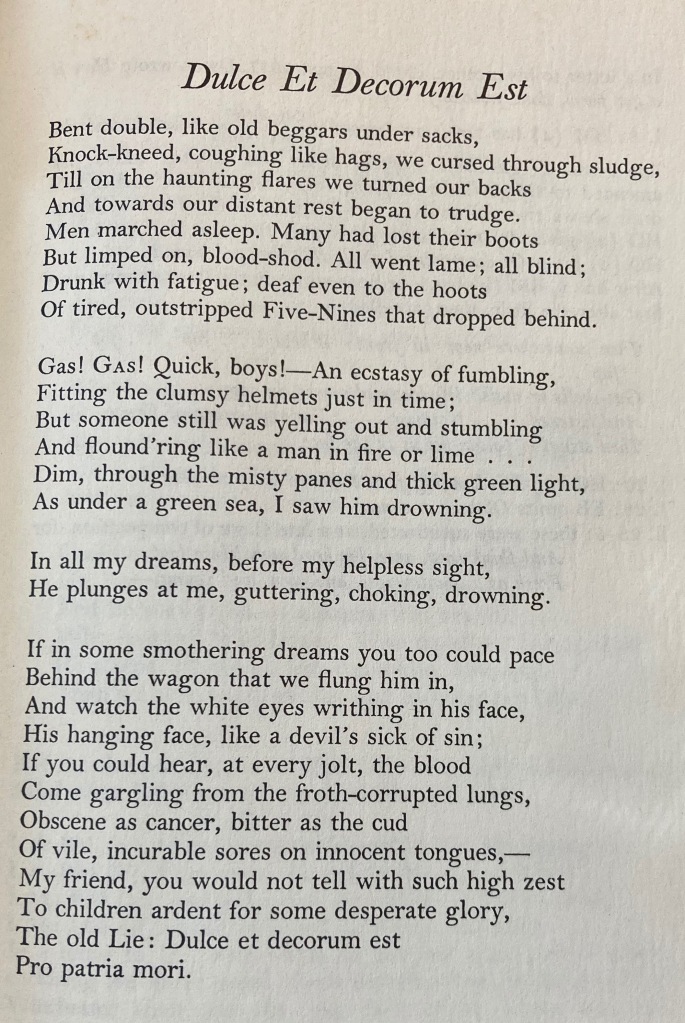Christmas Blizzard 1947
December 13, 2023 § Leave a comment
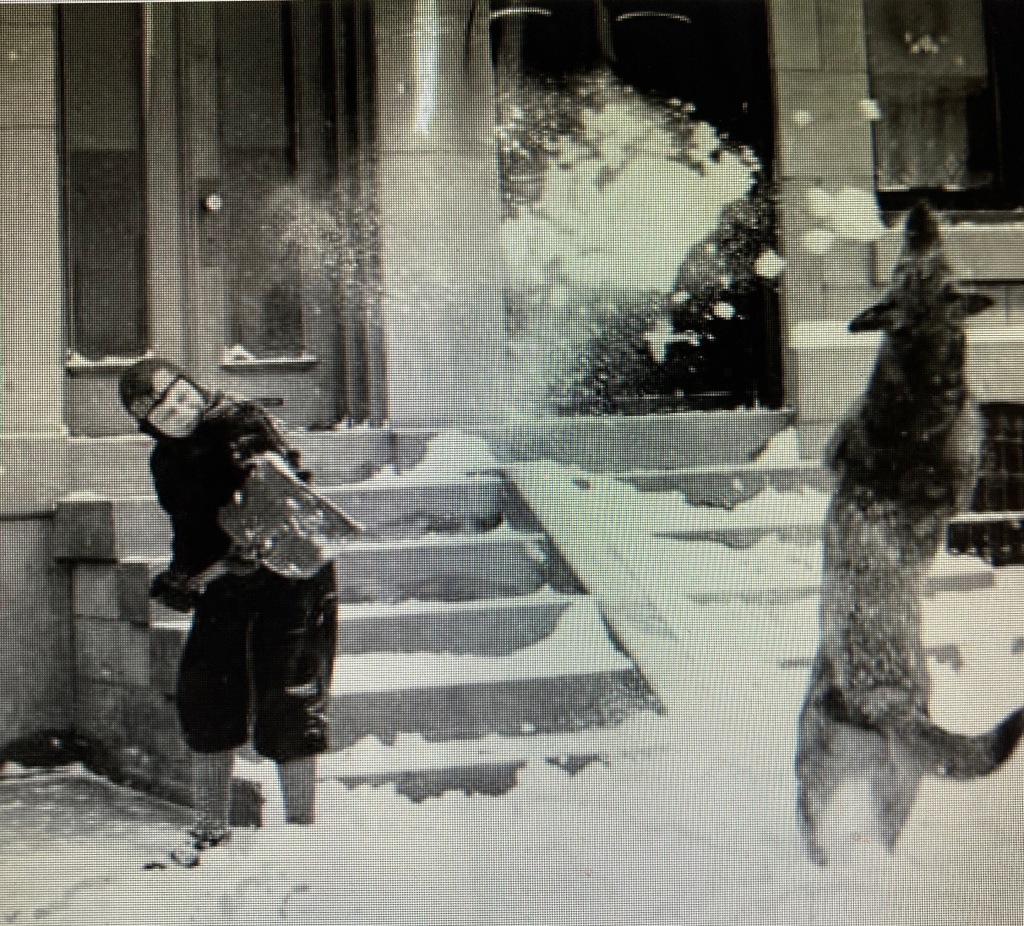
Philadelphia/ Christmas Day/ 1947/ Time to Play
Sometimes it’s serendipity or, maybe, sometimes a message from beyond the veil prompting a writer to narrate a scene in a particular way. Thus it was when I was writing Christmas 1947 in Sketching with Renoir.
Christmas Eve
On the afternoon of December 24, 1947, Loganville was preparing for a modest Christmas Eve. May Bickles went with girlfriends to hear the Wanamaker’s Christmas organ performance. Olivia Sanders picked up a few last-minute presents for everyone with her Sears bonus. The drugstore at Summerside had seen more than one husband looking over the perfume and cosmetic counter and asking questions. A big box had come late in the afternoon to Lannon’s for the Bells all the way from Chicago. Lannon, himself, had driven over and delivered it since Bell or his daughters rarely stopped by the store. He didn’t know where they got their provisions, but maybe they did all their own butchering and grew their own food on the land. Lannon was curious about the whole operation so he didn’t mind dropping off the box.
He felt badly going by Louie Schmidt’s house and figured he should do the Christian thing and stop in and see how Louie was doing. He’d do that over Christmas week.
Wally wrapped another row of red and green lights around the front door of the gas station’s store and entwined their little spruce tree in the side yard with multicolored lights. This section of road from Summerside to Loganville was very dark. It would be cheery seeing those lights midway between the two towns. Not too many folks had lights up and around their homes on that stretch, maybe a candle in the window but no big displays, not like in the city where the whole place lit up.
If the outside of houses were not bedecked, that could not be said of the interiors. Everyone had a Christmas tree in the living room, and most of the homes, especially the Sanders’ home, smelled of cinnamon, nutmeg, nuts, and oranges and about any combination of cookies and hard candies. No one skimped in that regard.
The Boudreaus had fudge that Theo made, and Ev tucked gingersnaps in with the bowl of red apples, nuts and assorted Christmas cookies that she had Theo buy at the Summerside Bakery. Cleo’s contribution were homemade Christmas tree decorations, which hung on their tree along with their final garnish of silvery, lead icicles that shimmered in firelight.
It was dark by the time Theo went outside to get more wood for the fire. The Boudreaus wouldn’t be going to Midnight Mass this year, not with Ev pregnant and Cleo still getting over a cold. Theo stacked the wood in his arms. Looking up at the sky, he felt wetness in the air, but there was no ring around the moon even though the sky was cloudy.
As he turned to reenter, he stopped. There was his family framed in the lighted living room window. For a moment, he felt as if he was intruding on someone else’s life. Then the word “mine” struck him with the force of a blow. It was like the “start” you get seeing your face reflected in a store window when you weren’t expecting it. Disorienting and then familiar. He shook off the odd feeling, stamped his feet, and went into the house.
Let me intrude here as the author: It just seemed natural that Theo would have this experience, looking up at the sky after gathering wood, feeling the wetness in the air, but then seeing no ring around the moon fortelling any snow. If anything,, while writing, I was surprised by his reaction seeing his family through the lighted window and the funny feeling of intruding on someone else’s life and the shock that it was his own. It made me love him more for those confusing feelings. I thought, well,I’ll deal with that later but, right now I think I’ll just plot out some kind of snowstorm and then because of—an “I wonder ” crept in and “Oh, might as well” and knowing I was going to pick up the snowstorm stitch anyway the next day, I closed off that day’s work and went to Google and keyed in, Christmas 1947, Philadelphia and Lo and Behold.
https://en.wikipedia.org/wiki/North_American_blizzard_of_1947
Blizzard
The Northeast Christmas Blizzard of 1947 caught everyone off guard. It rose up off the Atlantic Ocean, which was odd since these storms usually came out of the west. Later Theo wondered if that was the wetness he had felt in the air the night before.
Snow started falling lightly on Christmas Day. Cleo had jumped out of bed in the gray dawn and tiptoed into the living room with its smell of evergreen and spent embers. She felt the sagging heft of the wool stocking hung on its nail by the side of the fireplace. It was a special stocking her Grandmother Boudreau had knit for her and it had reindeers on it. She felt the antlers and the bumps and curves of the stocking’s bulk and the fat orange she knew was in the toe. Unhooking the stocking in the dim light, she glanced over at the tree but not down at its base because she didn’t want to see right away if Santa had left her………
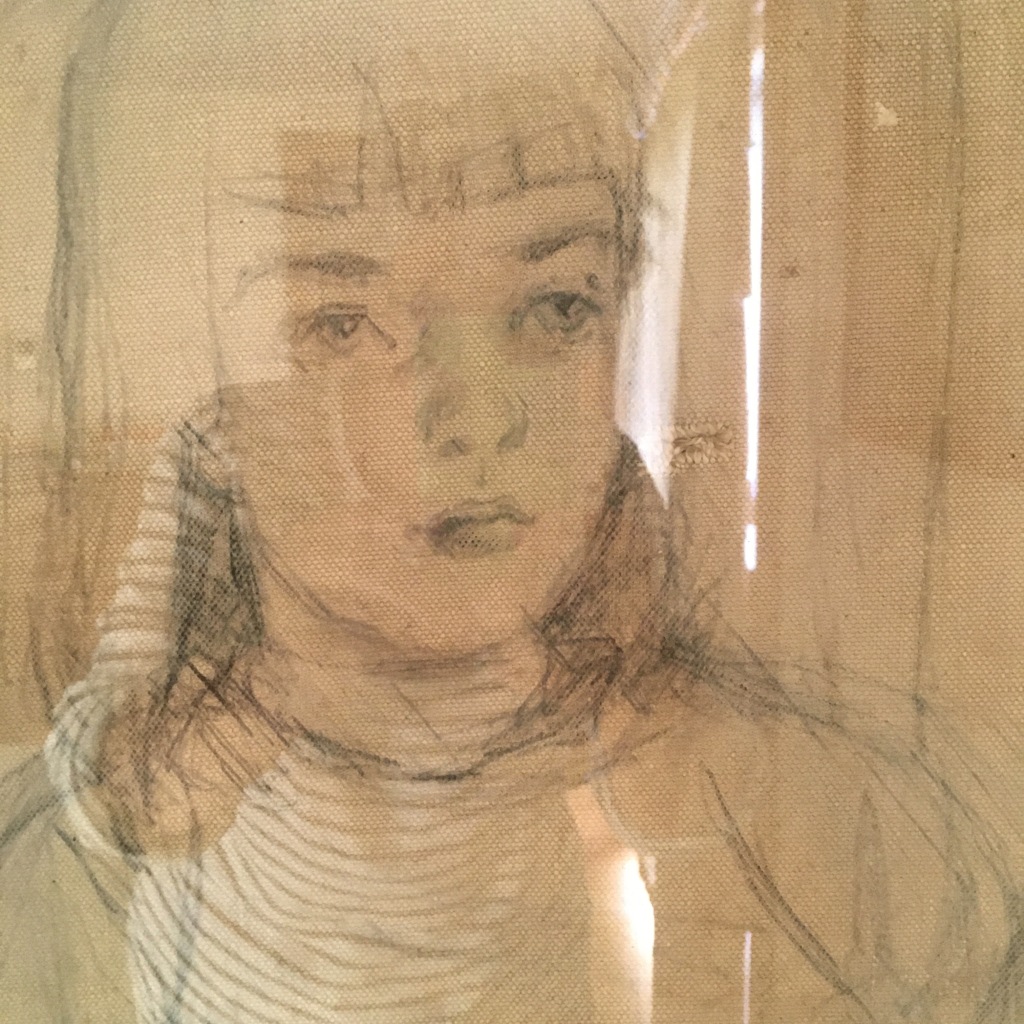
But, of course, to reveal the outcome of this tantelizing last sentence, you must go to:
https://indieauthorbooks.com/fiction/sketching-with-renoir/
Especially,this might be of interest to those who lived in the Northeast of these United States and were around during the Great Blizzard of 1947! Bundle up!
The Big Game
November 22, 2023 § 1 Comment
OK, Football fans, (though I retired my “watching” jersey years ago) I do have a football scene in Sketching with Renoir that I would like to share.
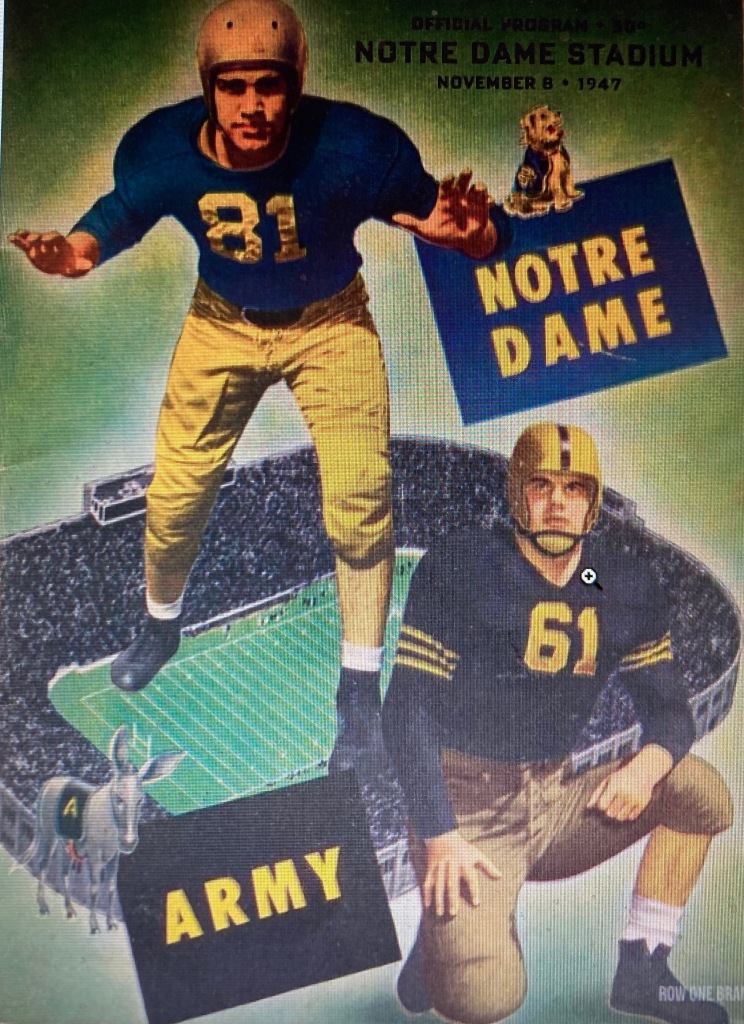
It’s the 1947 Army/Notre Dame Game and Cleo and her father are positioning the Woody for the Big Show.
That Sunday afternoon, Cleo, her father and Kip got into the Willy and drove down the field towards the woods and, after circling around, found the right spot to park. They had a bag lunch of baloney sandwiches and cookies, some milk for Cleo and two bottles of beer for her father. Her mother was taking a nap. Kip also had dog biscuits in the brown bag. Cleo was wearing her favorite clothes: her green corduroy pants, her yellow Roy Rodgers sweatshirt, and her cowboy hat with the string-tie and red button on its slide. She played with it while her father was circling the field. He had the radio on, the dial set for the station that would soon play the game. Every so often, he stopped the car to test the radio reception. When he found the exact spot where the announcer’s voice wasn’t crackly, he stopped, got out and made sure the antennae was up as high as it would go. They did this when the Notre Dame games came from Indiana. Her father always said, “It’s the damnedest thing. When the games come from South Bend, I can never get reception except in this field. Isn’t that something? Isn’t that something?” He would say this several times, laughing and shaking his head.
Cleo liked these times with her father. They were like the times in the morning when he would make toast and talk with her. It was different than being with her mother. He didn’t worry if Cleo’s hands were washed or not. She had never seen him cry or spend long times in the bathroom. But, he didn’t read her as many books as her mother or let her hang up laundry. It was just different.
“Oh, boy. They’re taking the field. The Fighting Irish.” This was also what her father said every time they had found the right spot and the game was beginning. Those words. “The Fighting Irish. The Fighting Irish!” He loved saying those words as he opened a beer. They picked up their sandwiches and took bites of baloney and her father gave Kip one of the biscuits.
“Notre Dame will receive.” The announcer’s deep voice filled the car. Cleo didn’t know what that meant but she nodded.
“And, there’s the kickoff.” The crowd’s roar could be heard in the radio and her father took a swallow of beer and another bite of sandwich. The announcer’s voice got higher, “Oh my! Reception! Reception! It’s Brennan. Brennan has the ball. There he goes! Oh my. He breaks loose from one. Now, two. He’s clear. He’s clear. Oh my, look it—he’s running it . . . scampering down the left-field line.”
Her father was yelling. “He’s got it! He’s got it! He’s running it back!” Her father was banging the steering wheel and a bit of sandwich flew out of his mouth. “He’s goin’ all the way,” the announcer’s voice filled the car.
“Czarobski just blocked one; Lujack got the other.” The man in the radio was yelling, “Touchdown! Touchdown! Brennan with a 97-yard kickoff return.”
Her father was pounding the wheel again. “The Fighting Irish, my foot. Ziggy Czarobski, Lujack, my foot. The Fighting Irish!” Her father kept pounding the steering wheel. Cleo had no idea what it all meant except in the end, Notre Dame won 27-7. Her father tooted the car’s horn all the way home.
Now, the Time Machine Report:
Watch Brennan, Go.
If you want to score another touchdown, here’s the link: https://indieauthorbooks.com/fiction/sketching-with-renoir
A New Leaf/A New Book
November 16, 2023 § 2 Comments
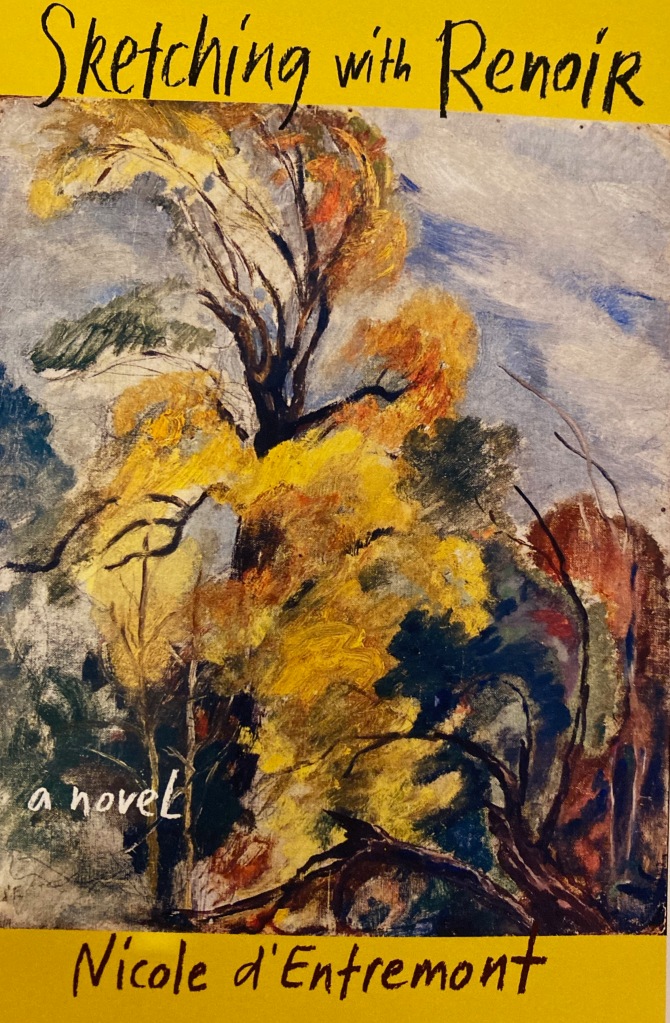
Sketching with Renoir takes the reader to the fictional town of Loganville, Pennsylvania, a rural community outside of Philadelphia, where a young family is beginning their post WWII life. The woman, an artist, her husband, a fledgling architect and their five year old daughter are each searching for their own footing. I see families this way— a mix of personalities joined in love and conflict.
The first scene opens as Ev, the artist, sits at her kitchen table sketching, Renoir’s, Reclining Nude.
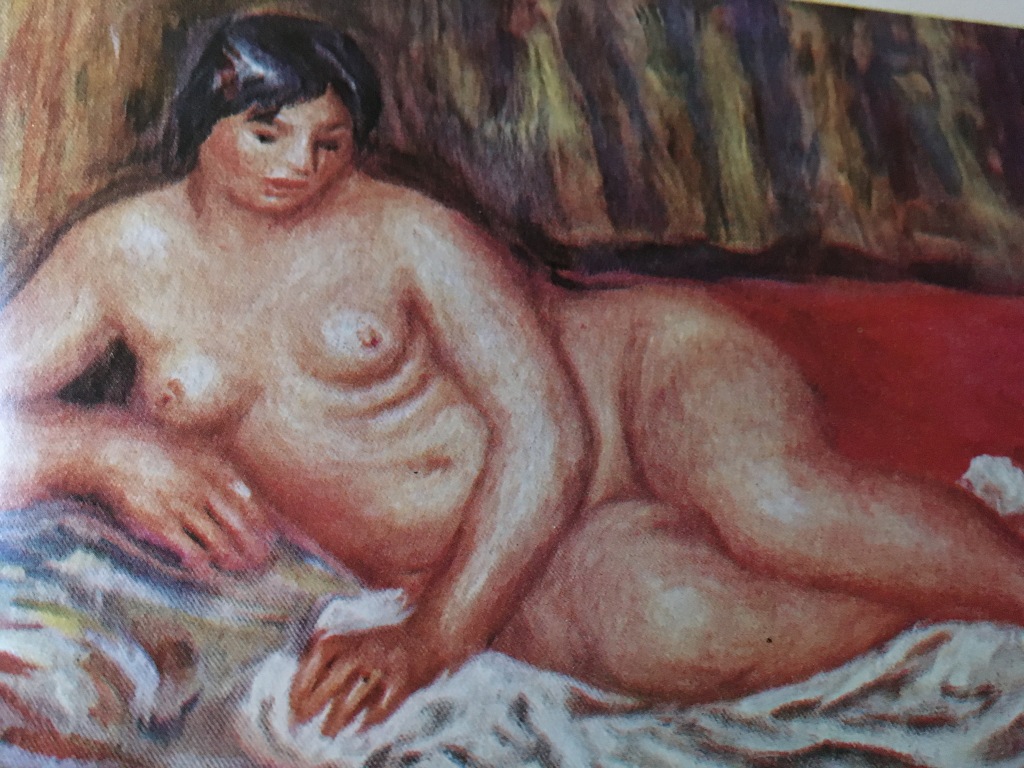
And, the subsequent observation by her five year old daughter, Cleo, that that the right hand, upon which the nude leans, is larger than the left. For this and other revelations, the reader must continue reading.
The following is one Endorsement for Sketching with Renoir
The delicate threads of everyday life and desires are examined keenly in Sketching with Renoir by Nicole d’Entremont. With her ability to evoke a physical setting using appeals to all our senses, d’Entremont has a way of showing the souls of characters caught between the said and unsaid in a way that makes us understand them fully.
Now, she did not see the trees but saw, instead, the line of his hand and arm, the profile of his face, the setting sun behind him casting long shadows on the grass, there was a riffle of wind, a tinge of late summer warmth, the musk of golden rod, Queen Anne’s lace. How to get all into a painting?
The elegant prose guides us through world events like the storm of New Years’ Eve in 1947 and the power of a tiny memento from the tragedy of World War I: one small button that demands attention and induces the man who treasures it to undertake a profound change.
In Sketching with Renoir, Nicole d’Entremont creates an emotional journey with vivid characters who take the reader with them.
—Rosanna Staffa, author of The War Ends At Four. Regal House Publishing, Raleigh, N.C.
Pitching one’s own book is not easy for most authors I know so what I hope to do every so often in this current blog is to provide a sample of the book’s narrative, an appetizer of sorts, so you, the reader, can decide whether it is a book of interest. Pretend it’s a reading in the very own bookstore of your mind and see if you want to continue.
Of course, if at any moment you are so stunned by the confluence of words, you can order your very own copy immediately from https://indieauthorbooks.com/fiction/sketching-with-renoir/ or, if you prefer a personally signed copy, please write me/ Nicole d’Entremont/PO Box 11/Peaks Island, Maine 04108 and enclose a twenty dollar check to cover cost.
Until next post, Au revoir for now, Nicole
People to People Diplomacy: from Bricks to Pencils.
November 10, 2019 § 2 Comments

Paul Mann Habitat Team: First building site/Tân Hôi Trung Commune. We’re all cleaned up and ready to get muddy.
Then: Post Build, Hoi Xuan and in the classroom.

Handing out the Peaks Island Elementary School kids’ drawings at Hoi Xuan Elementary School where we’ll then be drawing up a storm as part of the Hoi Xuan/ Peaks Island Elementary School Cross-Cultural (Grades 3-5) Drawing Exchange.
After our Habitat build was over in Dong Thap Province, five of us returned to the Mekong Delta after we said goodby to the rest of our team in Saigon. We had made arrangements to re-visit the school where we first suggested the drawing exchange between Peaks Island Elementary, where I live in Maine ,and Hoi Xuan Elementary. During the past year, the two schools have exchanged drawings. The kids in both schools (grades 3-5) drew the lives they live, sometimes sharing sentences or words. Drawing, to me, has always been an international language like music or song or quite frankly like getting dirty and working with other people whose native tongue you do not share.
The photo you see above was taken on a Sunday morning where the schoolroom was packed with kids and teachers and officials from the community gathered there to greet us and to see the drawings I brought to give to the kids in Hoi Xuan from the kids on Peaks Island. It was also a time for the school and community to thank us for the project and for the gifts of paper and pencils that we brought to them from Maine, USA.
After introductory remarks, we handed out paper and pencils and drawings began in earnest as the Hoi Xuan kids got busy drawing their responses to the drawings the kids from Peaks had drawn for them. These kids, of course, have never met and live in very different cultures and climates to name just a few outstanding differences, but I was struck by the similarities in many of the images drawn and /or responded to. For example:
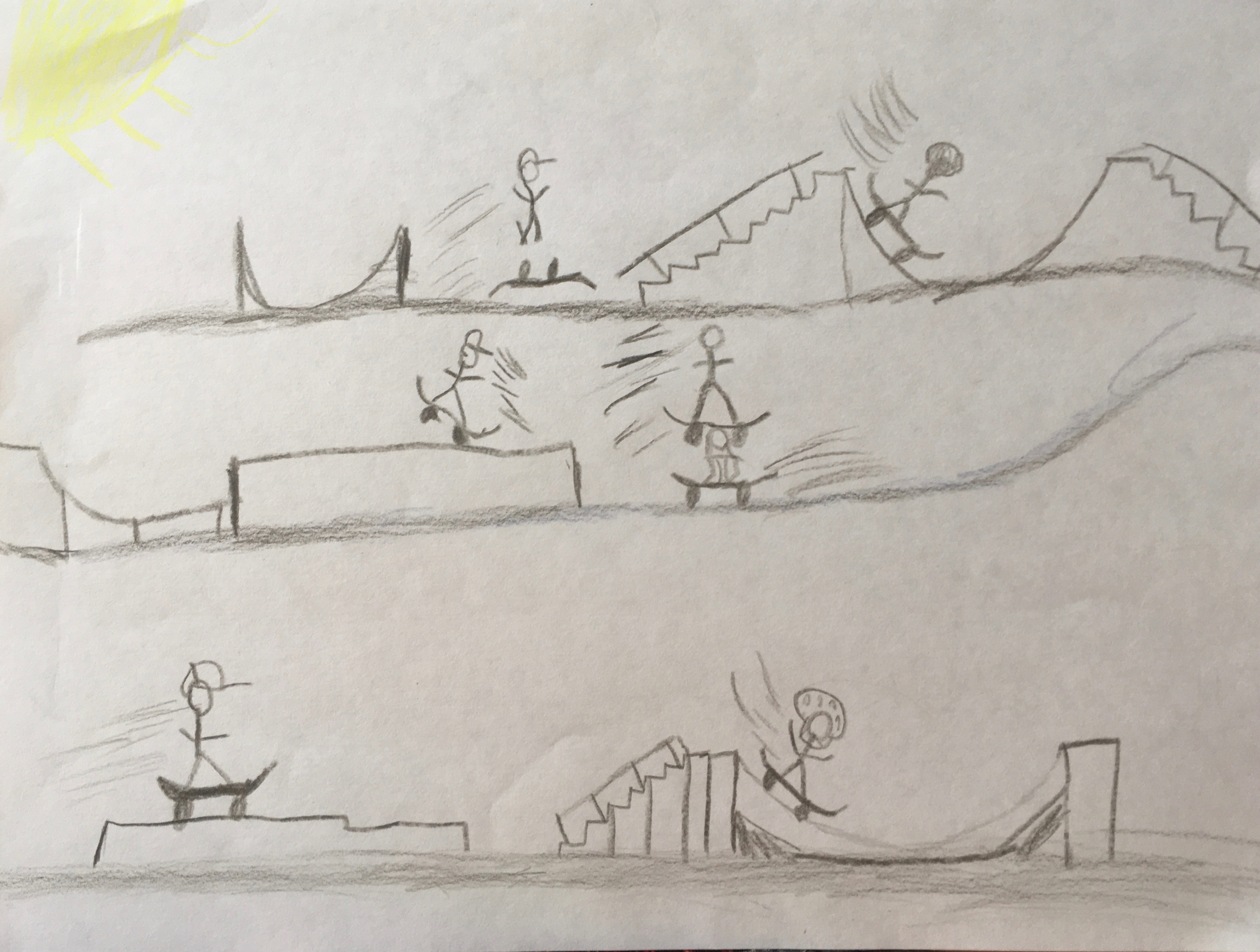
Here’s a Peaks Island skateboard drawing by one of the boys on Peaks. And below, one of the Hoi Xuan kids took inspiration and did a riff of his own.
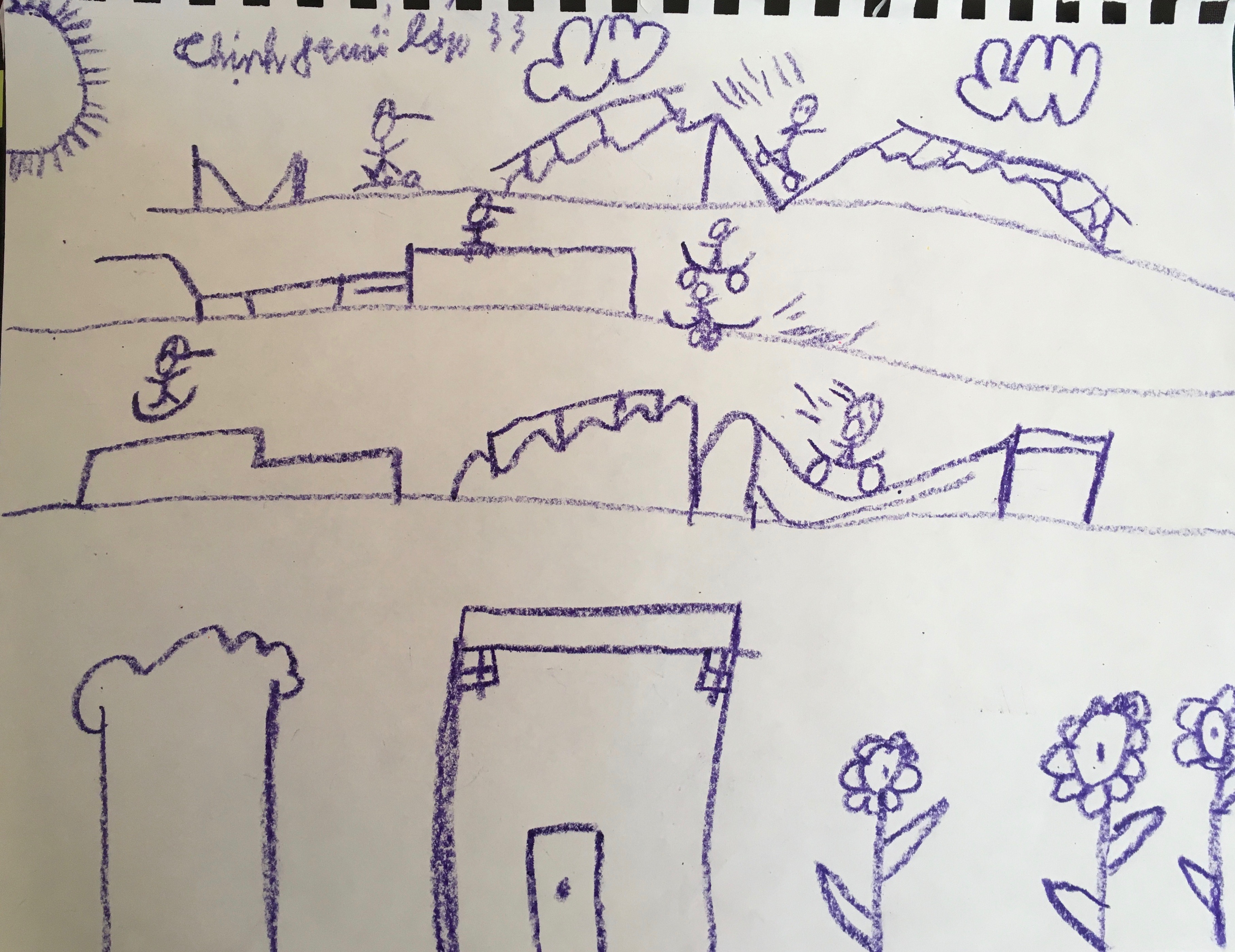
Birds were Big Subjects for both groups of kids: First, a Peaks variety.
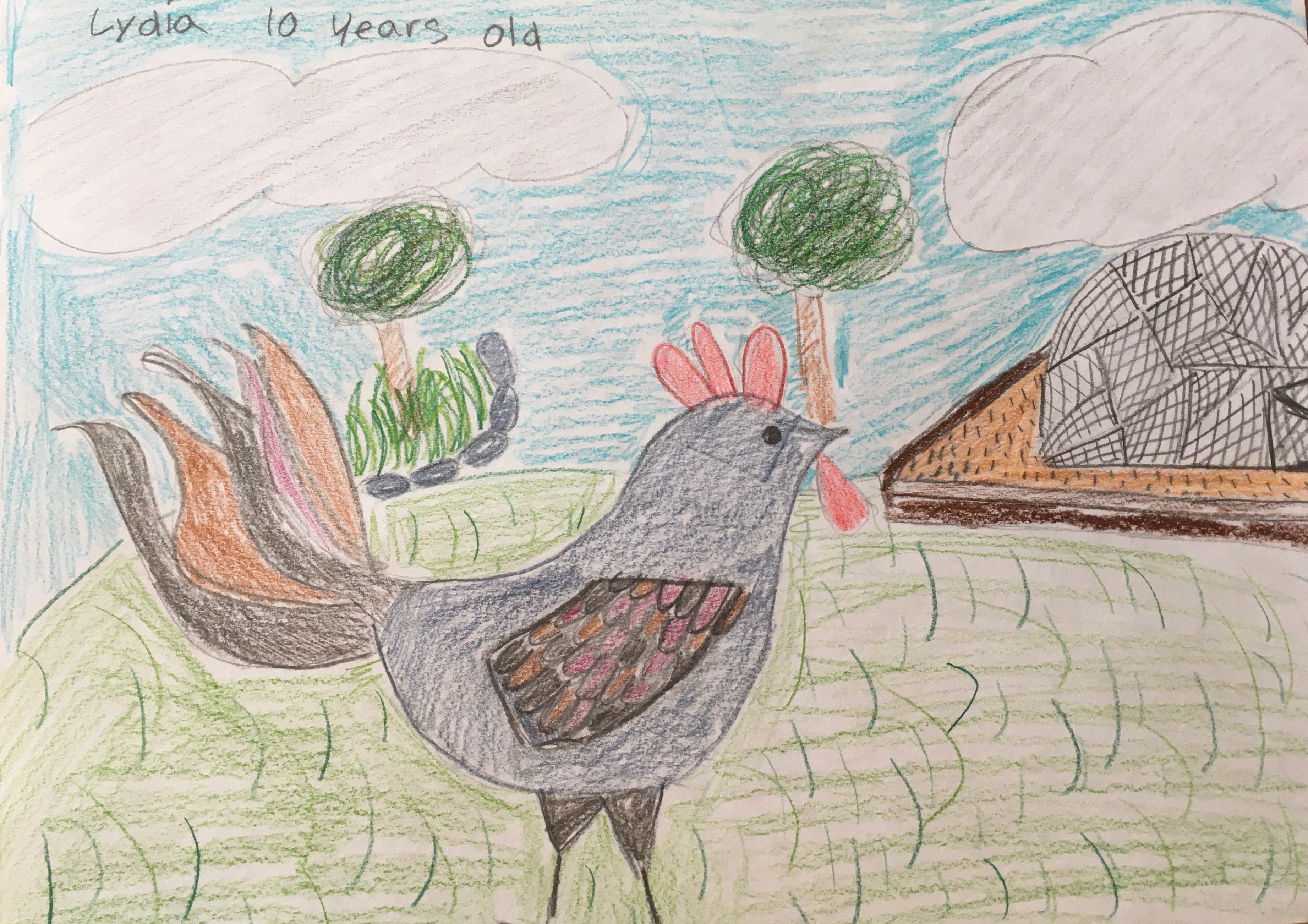
Then, a Rooster from Hoi Xuan.
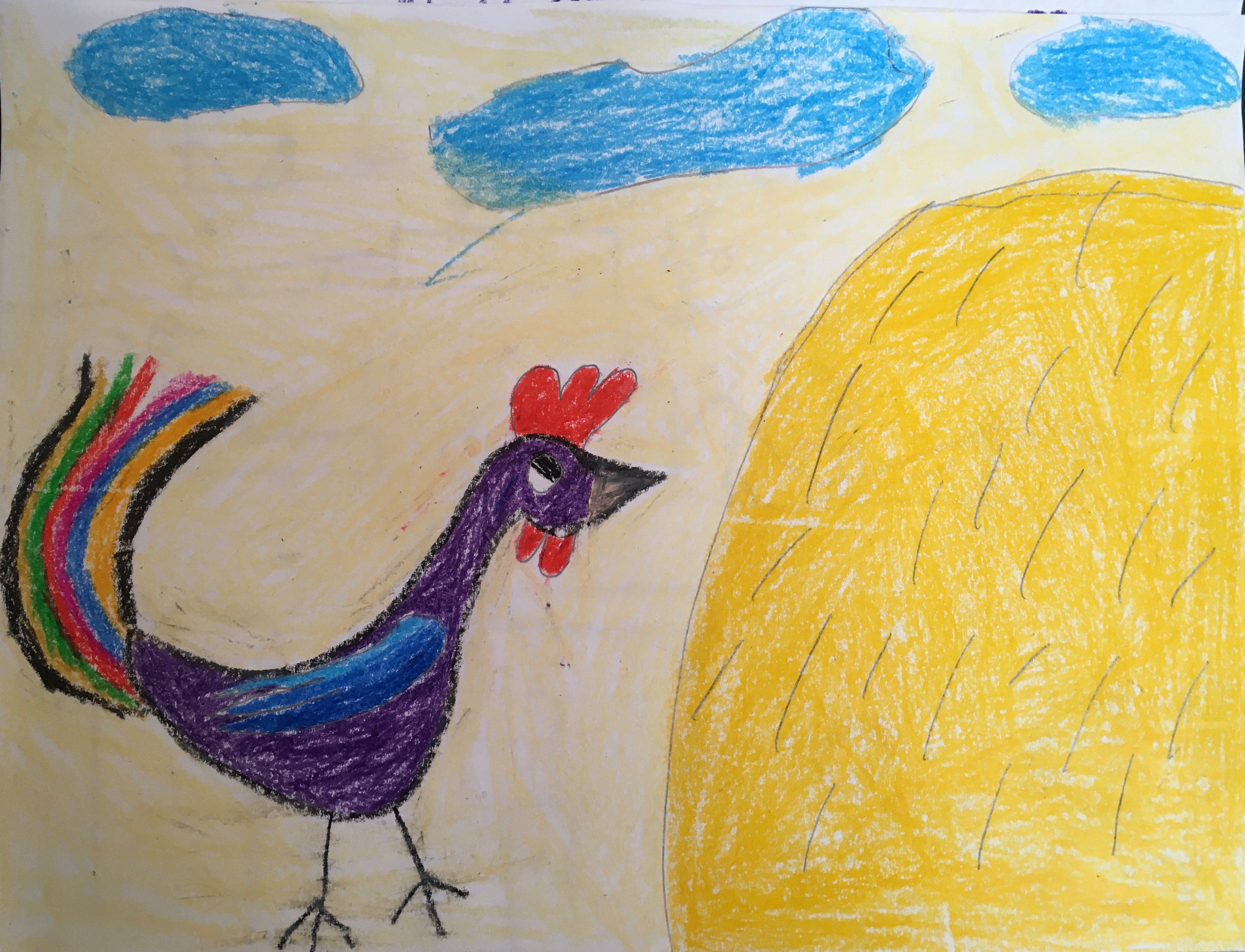
Who knew? Trees Have A Similar Shape. First, Hoi Xuan.
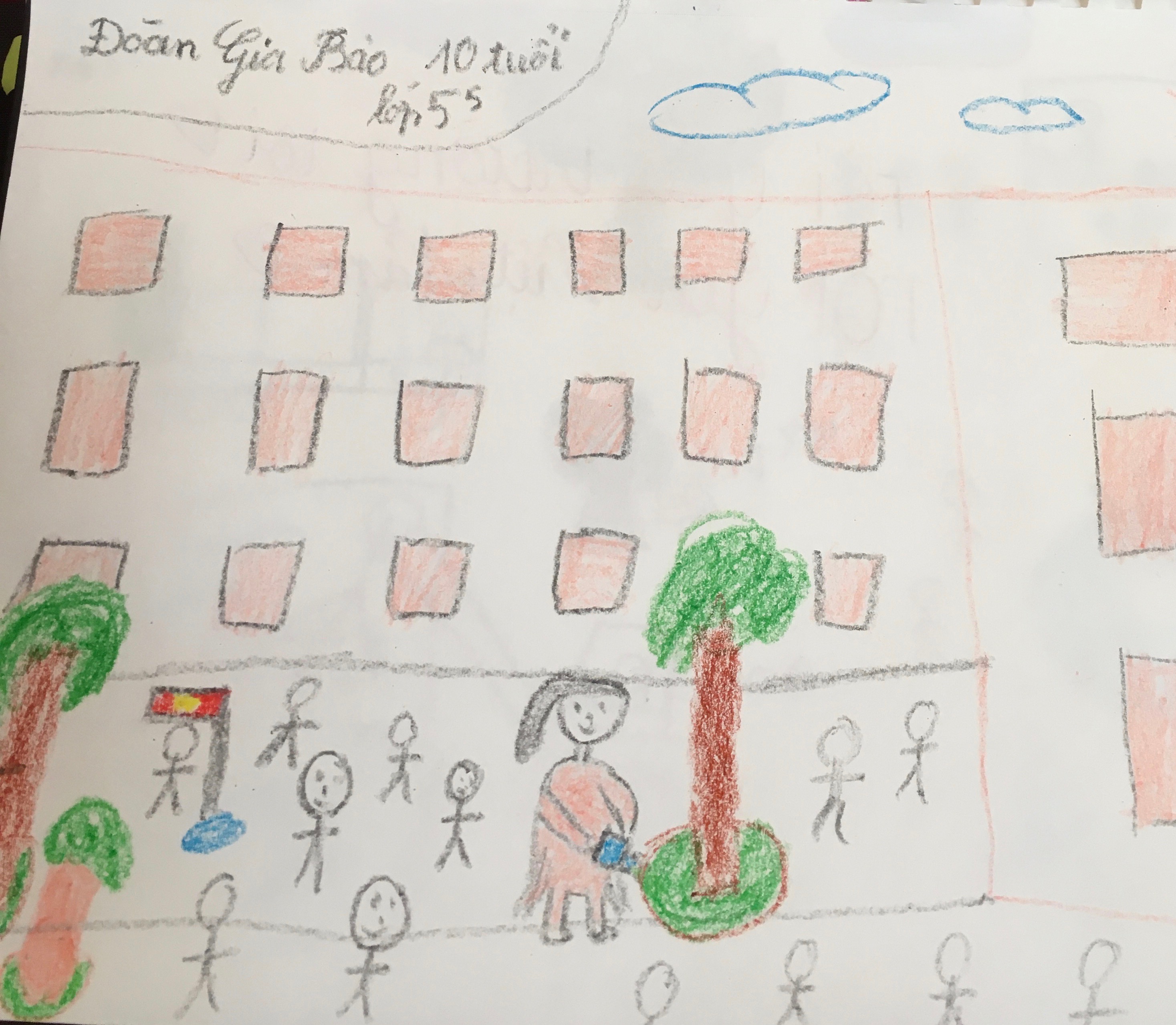
Then, Peaks.

Then, Blessings drawing (from Peaks) of a girl swimming.
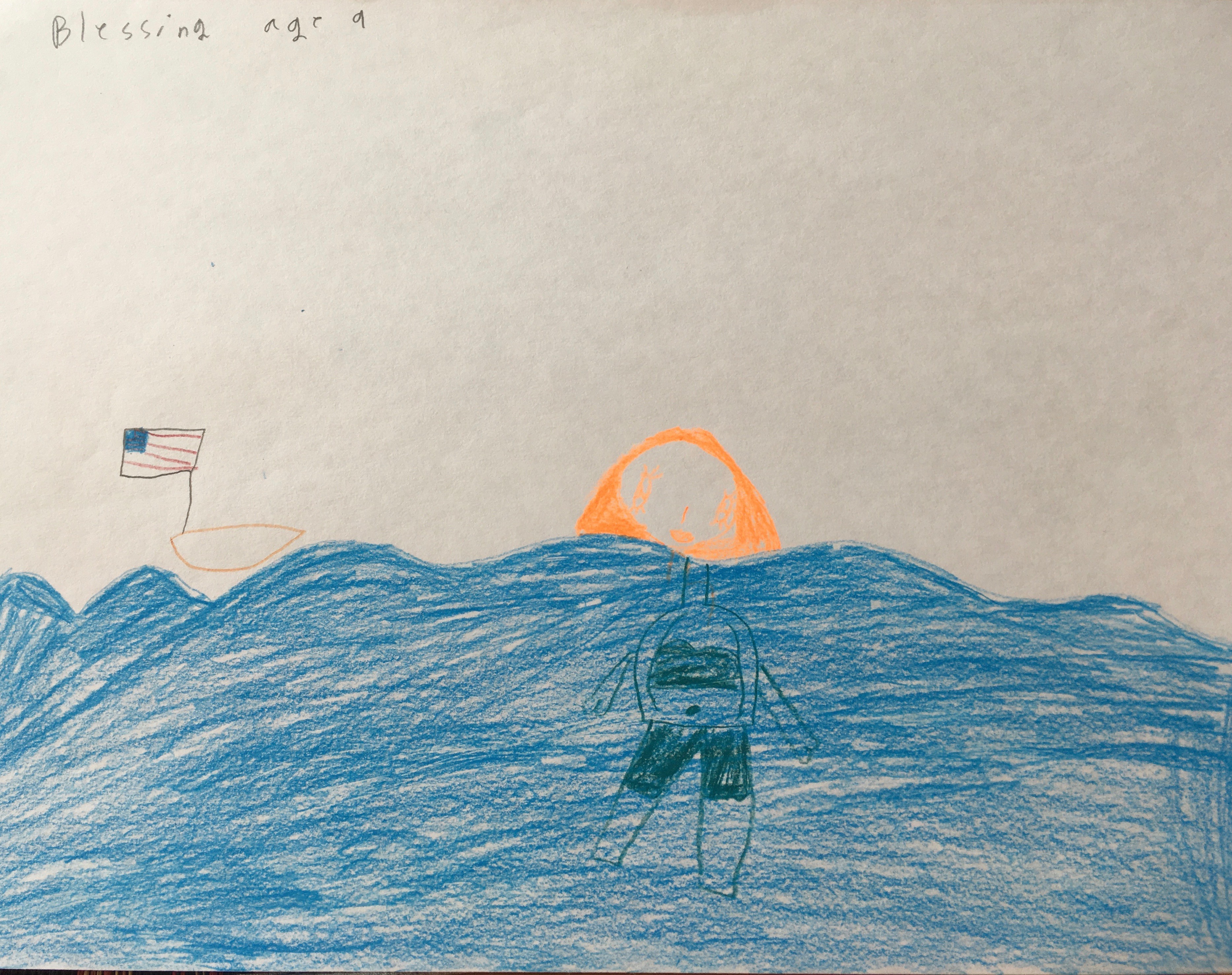
Has found its way to Vietnam.
Teachers participated.

Even local officials were drawn in.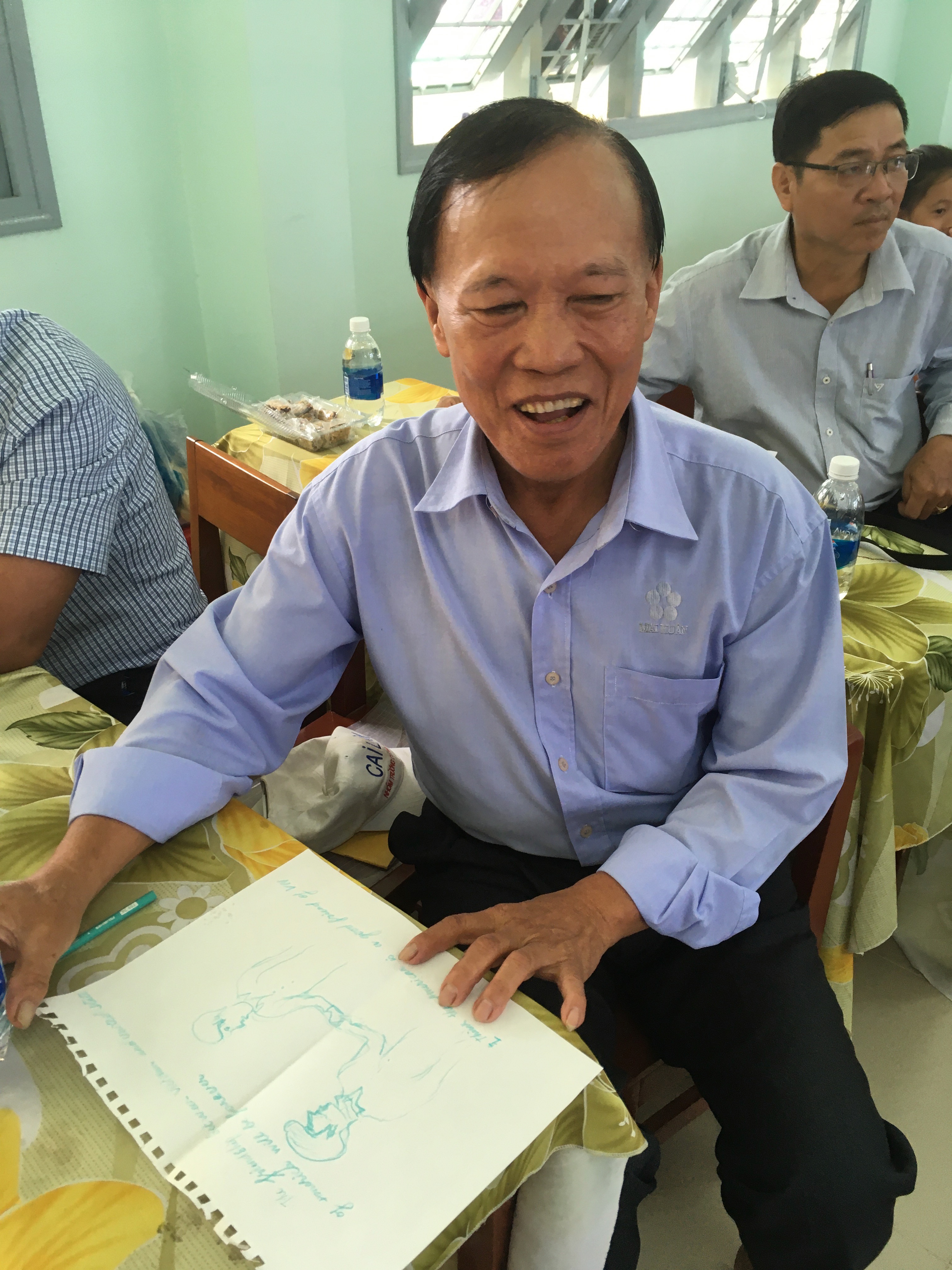
All in all, we had a wonderful day and I left with an emotional lift from this kind of sharing. What wonderful art was produced in such a short period of time! And, how the language of art can transcend supposed cultural divides. To help build a home with a family and to make art with children is to share a universal language, one that transcends the artificial geographical and political boundaries that are so often used to divide us as human beings. Perhaps we all need more bricks and pencils in our lives.
Roger Allen La Porte
November 9, 2019 § 2 Comments
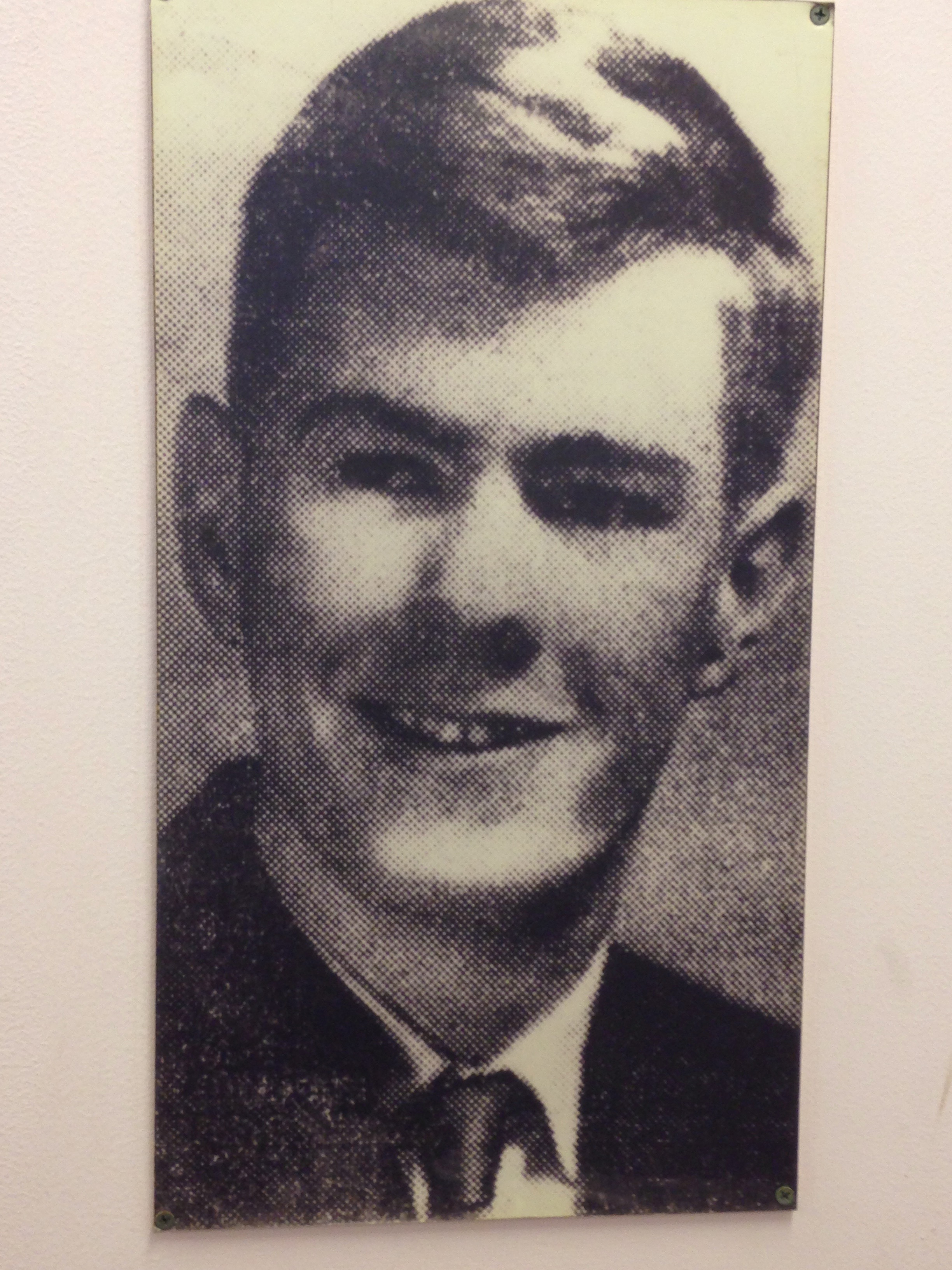
Fifty-four years ago on the evening of November 8th, 1965, I had what turned out to be my final conversation with Roger La Porte. Early, the next morning on November 9th, Roger walked to the United Nations Plaza and at 5:20 sat down on a little cement island on First Ave in front of the UN, doused himself with gasoline and immolated himself. According to the then morning paper, The Journal American, his mumbled words to attendants and police during the ambulance ride to Bellevue Hospital were: “I am anti-war, all wars. Give me water.” When asked if he did this to protest what was going on in Vietnam, he said, “No. I did this as a religious action. Water. Give me water.” The next day, Doctor Jacob Richards pronounced Roger Allen La Porte dead at 2:50 p.m. on November 10, 1965. He was 22 years old.
This event altered the lives of those of us who worked with and knew Roger. We were all young. We had the complicated and intense relationships of youth and a commitment to non-violence and the works of mercy. We were living and working on what then was the Bowery’s skid row in NYC. Immolation was as hard for us to grasp as any of our countrymen and women Today, not many people think about or know the complex story of Roger La Porte. If November 9th, 1965 is remembered at all, it is because that evening the first great northeast blackout in the United States took place. The plug was pulled on New York City as Roger clung to life in Bellevue Hospital.
I was 23 when these events happened. I am 77 now. I know that Roger’s death was not a suicide. But, what was it? The private conversation that I had with him that last night was all about his concern for his friends: one near death and stricken with a mysterious ailment in Saint Vincent’s Hospital and other friends who were facing arrest for burning their draft cards. Our activities at the Catholic Worker were under FBI surveillance. Roger’s questions to me that night were urgent and ones I could not properly answer. Did I believe a person could take another person’s pain and did I believe in God. Not exactly light topics but typical of Roger’s personal intensity. To the first question I said, “I didn’t know; to the second I said I also didn’t know, but felt there was some energy there, something beyond our comprehension, and I remember him nodding in agreement, his face ardent and very much alive. It was not the face of a depressed and defeated human being. But to go as far as he went is hard to grasp. Certainly, it is especially baffling for the Western mind.
I’m tired of martyrdom. I wish it would go away. We have too many martyrs. They are disturbing. They make it hard for us with their inconvenient yearnings for a better world. But, maybe that is the lesson of such a terrible sacrifice. We should be uncomfortable. Some actions remain mysteries. We don’t need all the answers and even if those answers remain elusive, we should be working harder for a better world.
From Peaks Island to the Mekong Delta
October 16, 2019 § 1 Comment
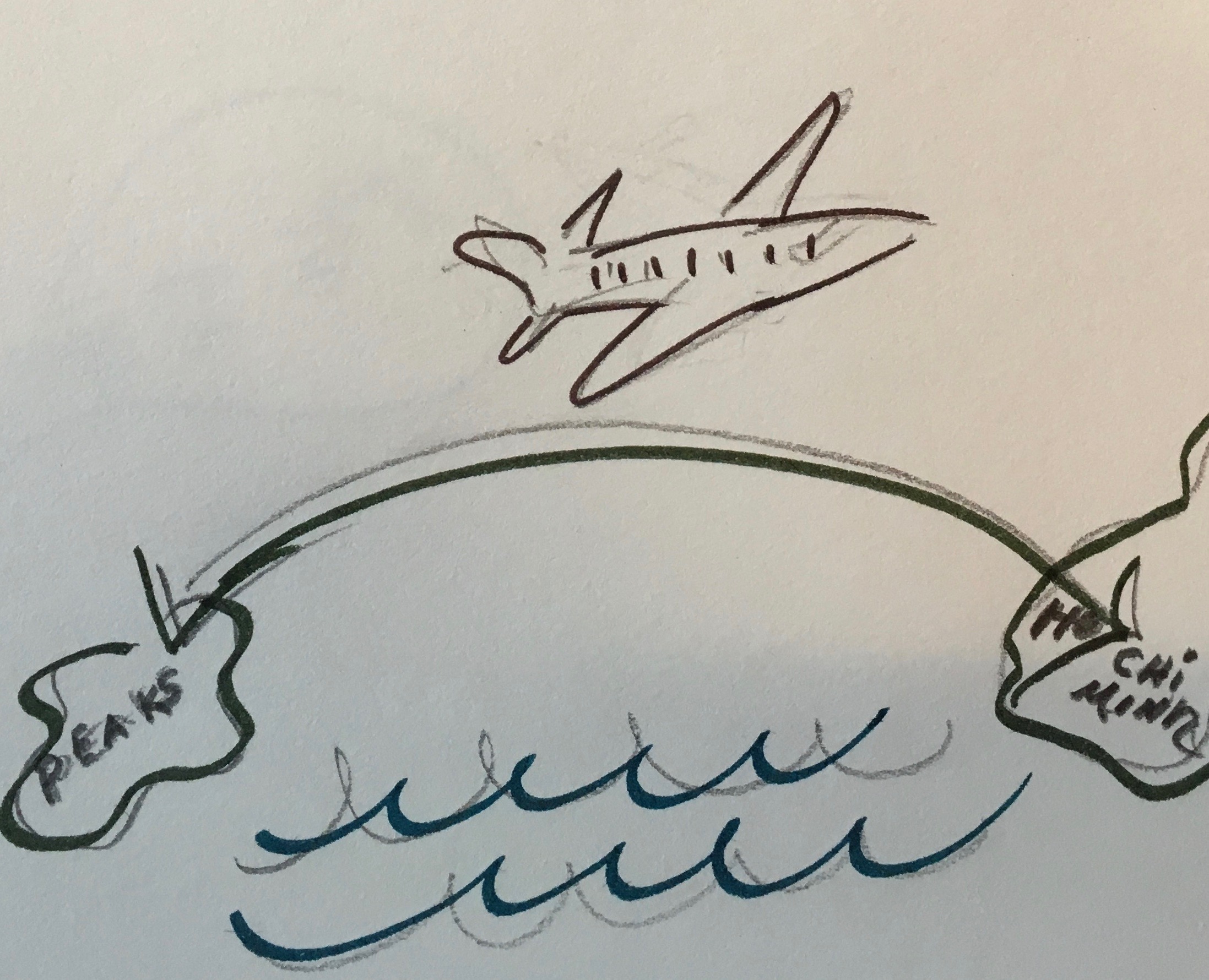
Tomorrow morning I take off for Vietnam to participate with a Habitat for Humanity team where we will help build in rural Dong Thap Province housing for two families, structures that are sturdier and safer than the current small homes they currently live in of metal sheeting, wood frame and broken bricks. Along with family members and skilled workers from the community, we will construct homes with a stable foundation, concrete floor and preformed metal sheets, homes that will especially help the families resist the intense storms that have increased in the Delta.
My little sketch above is not one of my best efforts since packing and fighting a cold has sapped a bit of my creative efforts but you are in for a visual treat to follow.
After the build is completed five of us will travel to the rural area of Hoi Xuan with our good friend Phuoc to visit again with the children of Hoi Xuan Elementary School and to bring drawings to them from the kids on Peaks Island Elementary School. Through this exchange of drawings the kids will be able to see what is similar and what is different about the way they live.
So I’m packing a great trove of Peaks’ drawings with me and I want to share a few with you below as well as a shout out to Keith and Ginna Christy owners of the Art Mart at 517 Congress Street. Keith and Ginna have donated a plentiful and wonderful supply of pencils and drawing paper for the kids in Hoi Xuan that I have also packed away in my bag. I know they will be appreciated.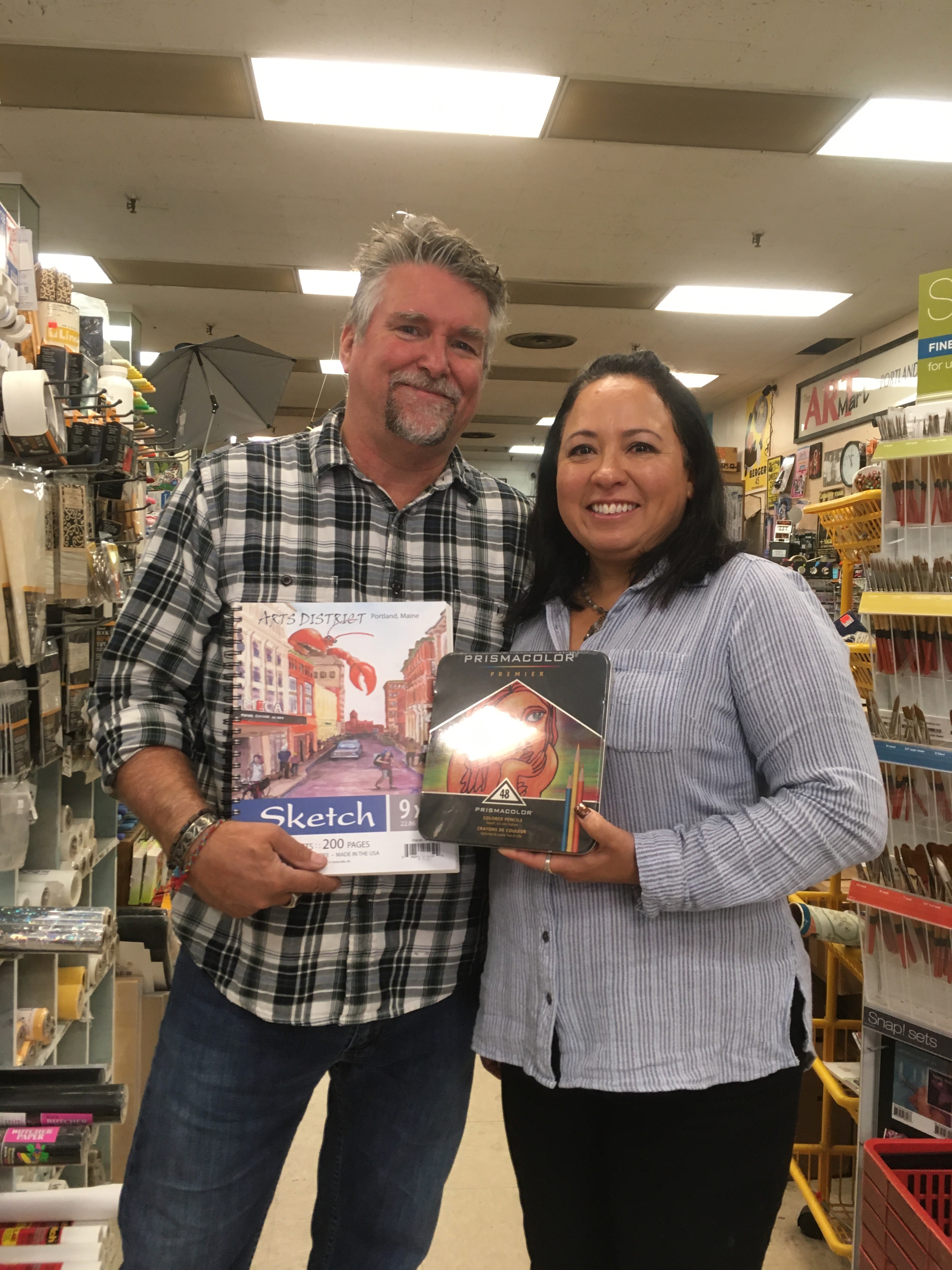 Here below is just a sample of what the Peaks kids are sharing with the kids in Hoi Xuan. We’ll pass out the drawings and Phuoc will do his magic translating. And then the kids in Hoi will begin their drawings.
Here below is just a sample of what the Peaks kids are sharing with the kids in Hoi Xuan. We’ll pass out the drawings and Phuoc will do his magic translating. And then the kids in Hoi will begin their drawings.



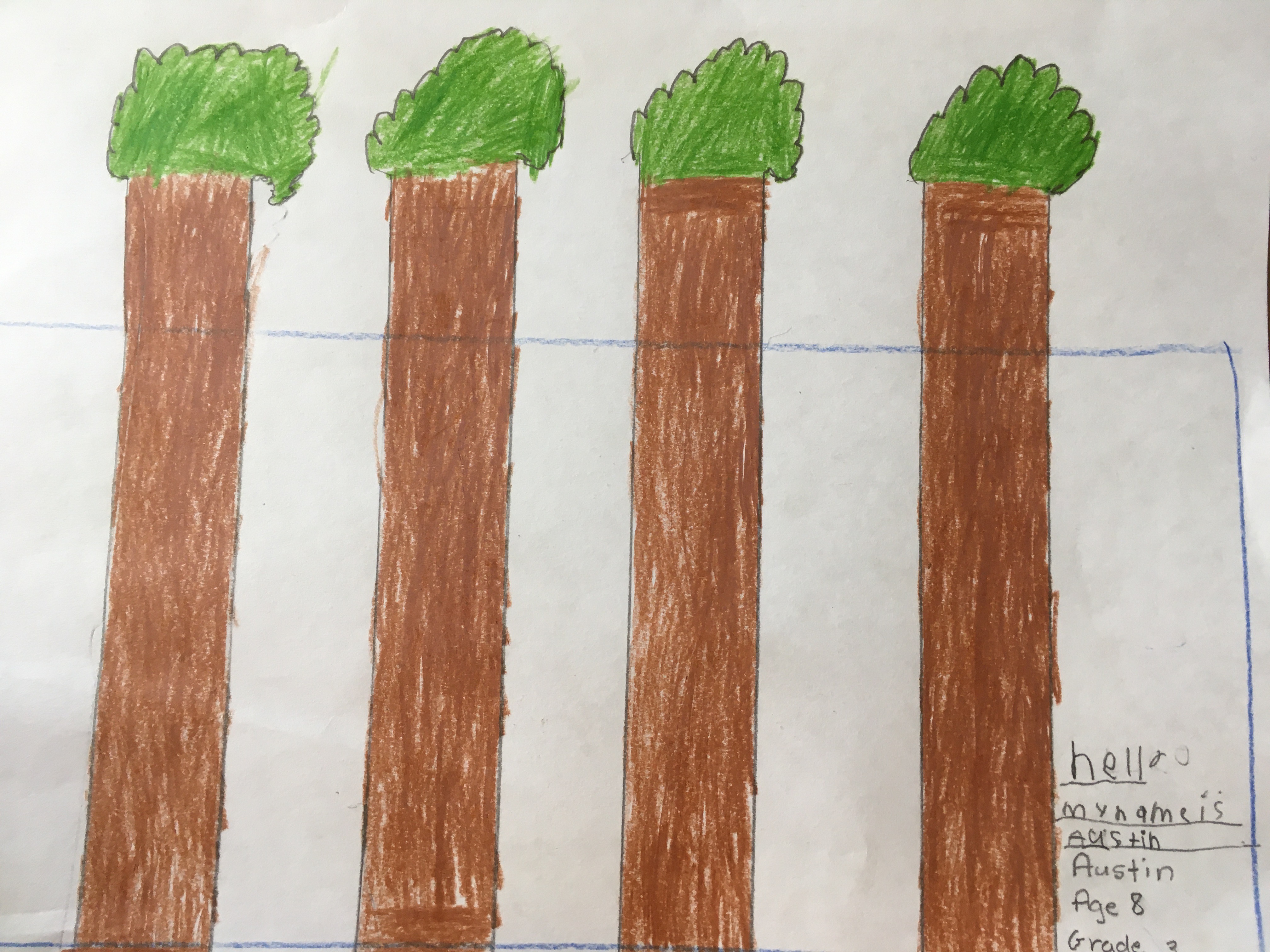
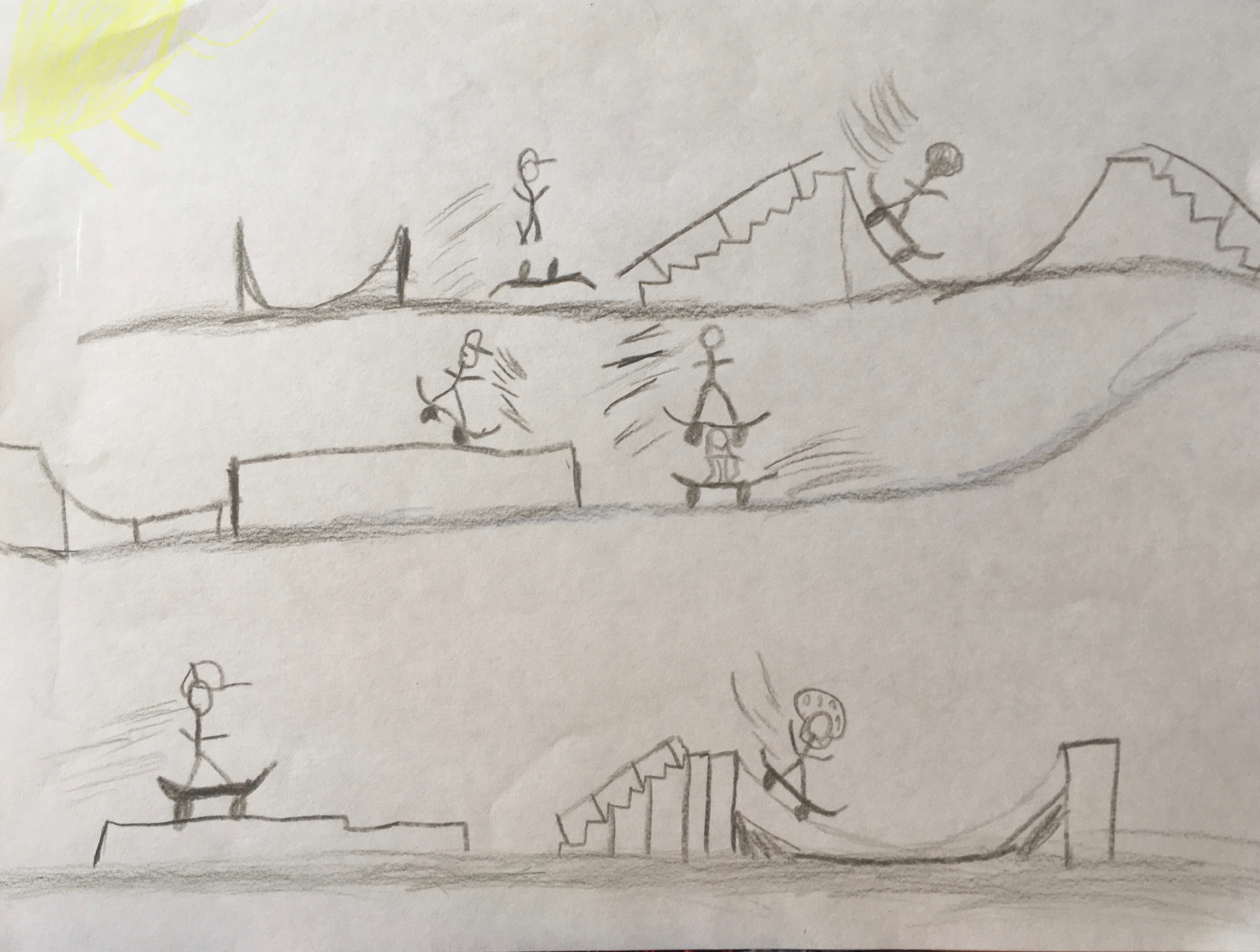
I wish I could publish all of these drawings and it will be great fun to see what the Hoi Xuan kids make of the stories and lives revealed. It seems like such a small thing to do but drawing puts us into a thoughtful and curious place and kids when encouraged can be masters at that activity.
To Be Continued.
Kids Drawing Exchange/Peaks Island, Maine and Hoi Xuan, Vietnam
October 11, 2019 § 1 Comment
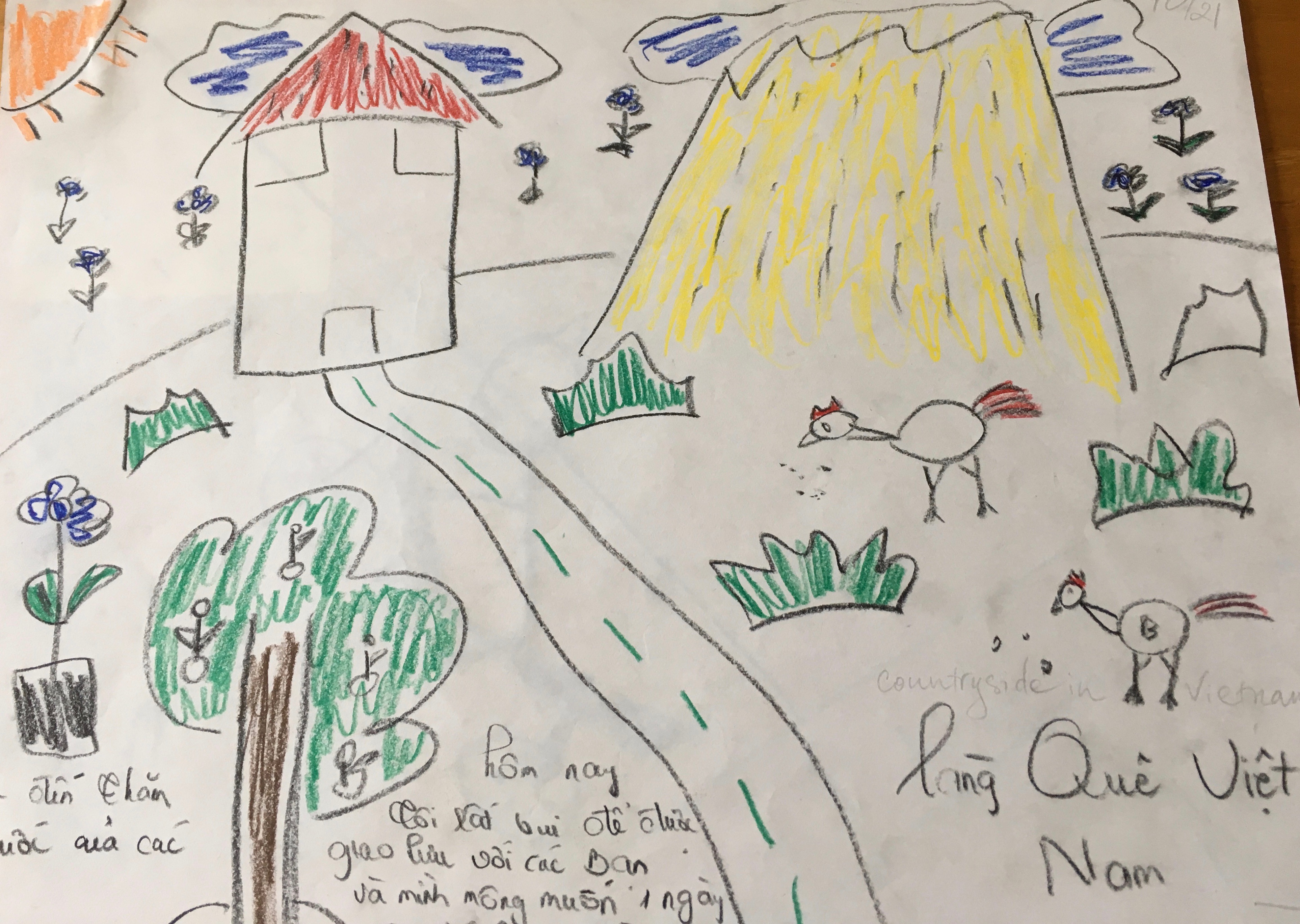
After our Habitat for Humanity building project in the northern Tu Ne Commune last year, we all returned south to Saigon and then several of us went to visit Phuoc and his family in Cai Lay. Phuoc had been our translator during my first trip to the Mekong and now we all were friends. Phuoc is very involved in a group of retired teachers and students who offer educational and financial supports to students in need from elementary to high school. One of these schools is in Hoi Xuan, a rural, elementary school some 75 miles from Cai Lay. Phuoc arranged for us to go to the school to speak about an idea we had about a cultural drawing exchange between Peaks Island Elementary where I live and Hoi Xuan Elementary. So, on a Sunday afternoon, 5 of us and Phuoc along with a driver bundled into a van and set off. Unfortunately, we ended up getting lost and arriving two hours later than we said but everyone was still waiting for us, the principal of the school, the teachers and the children.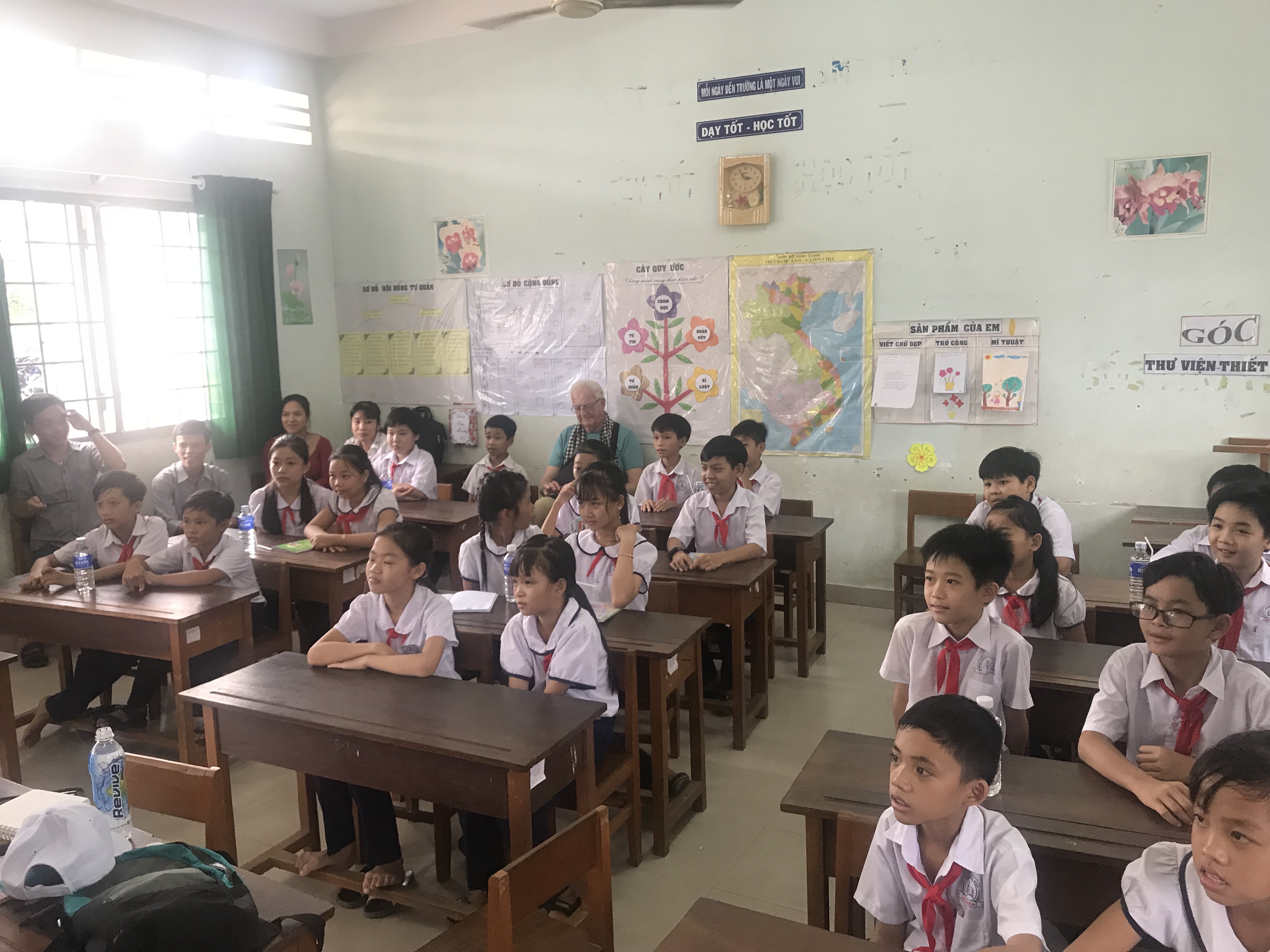
We introduced ourselves and… I explained how we had all flown from the United States to Vietnam, that I lived on an island in the state of Maine called Peaks. As I was talking I drew on the board to illustrate much of what I was saying while Phuoc translated.
I explained how we had all flown from the United States to Vietnam, that I lived on an island in the state of Maine called Peaks. As I was talking I drew on the board to illustrate much of what I was saying while Phuoc translated.
I asked Phuoc to tell them about our idea of the children from the two elementary schools exchanging drawings that would show how their lives were different and also how they were similar. Since Hoi Xuan is located in the Mekong Delta and Peaks Island is surrounded by Casco Bay both of those worlds have bodies of water in common. The kids were all in the same age range but so much is also different when neighborhoods are quite literally half a world apart.
Phuoc translated all this and then I asked, did the kids want to do it? Phuoc translated and the children responded in unison with an upward and downward lilt of voices and Phuoc took a step back with a funny, quizzical look on his face. I asked him what they said. He said,”They said, “No”. But why, I asked? Why wouldn’t they want to do it? He translated again and the simple and unified response was that they would not have the money to send the drawings to America. Both Phuoc and I assured them not to worry, that we would find the money to send the drawings back and forth. With that impediment resolved (and another lesson learned for me) Phuoc and I handed out paper and pencils that I had brought from home. Then….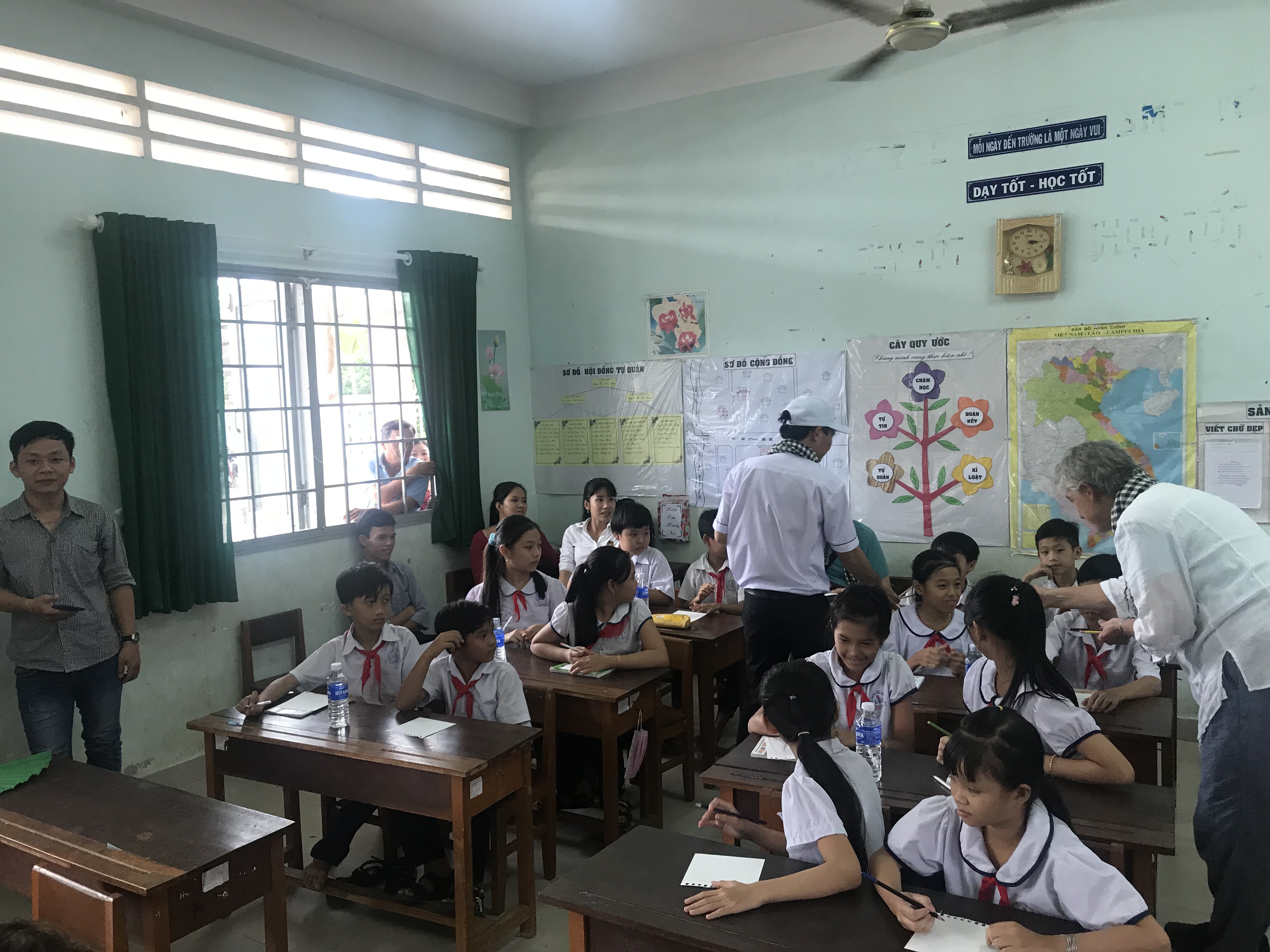
The kids (as well as Paul, our fearless team leader and my own Saint Andrews Elementary School childhood chum, got down to the real business of drawing their worlds to share with us.

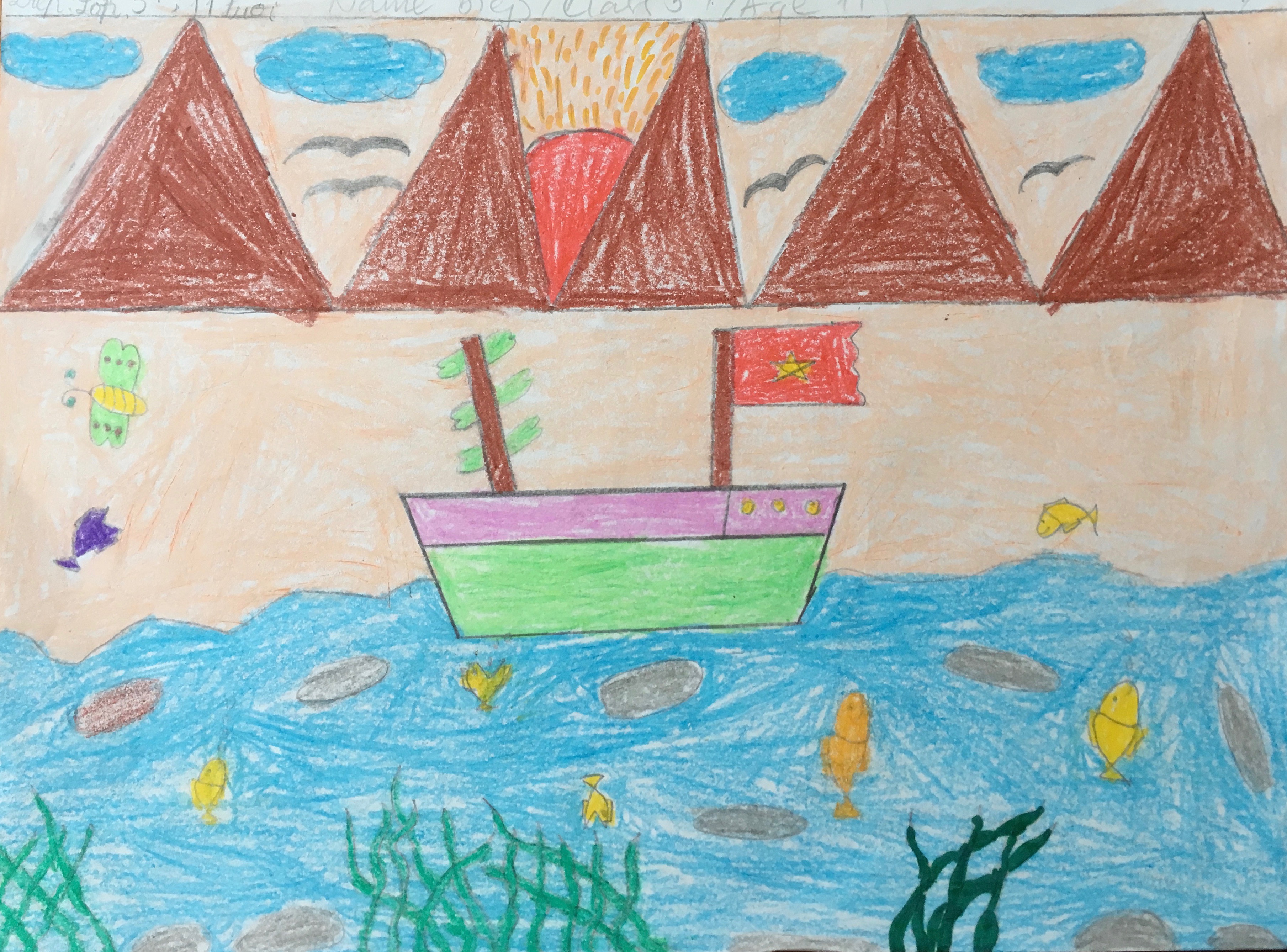
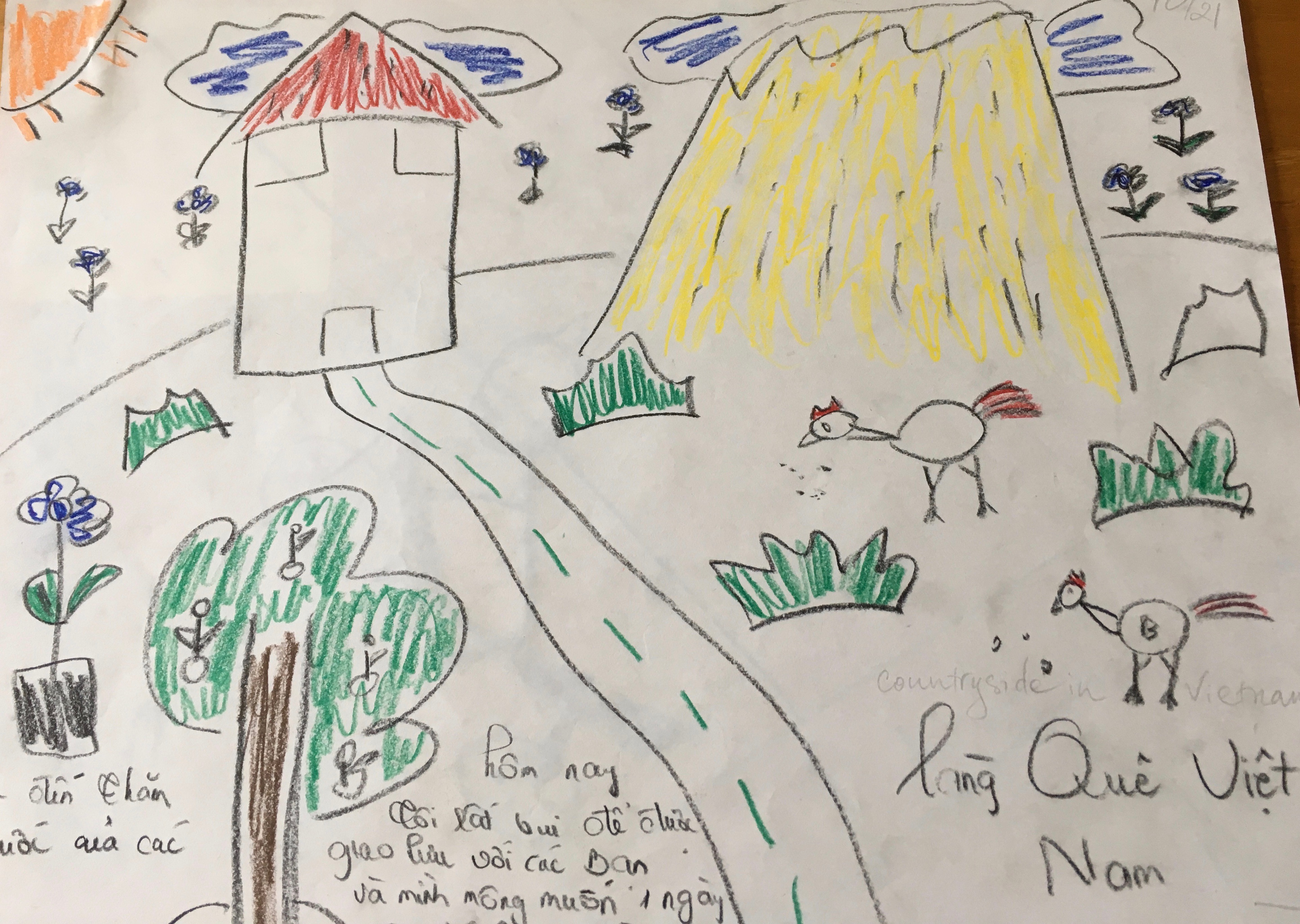
To Be Continued.
Back to Saigon and the Mekong
October 5, 2019 § 3 Comments
I first went to the Mekong Delta with Habitat for Humanity Global two years ago to assist a family with building their new home. This October 17th, 2019 I will return to the Mekong Delta again to do the same activity with another family. This will be my third trip to Vietnam.
I hope to record this trip differently through words, images and drawings of contemporary Saigon, the Mekong, my fellow team members and people I meet on the way.
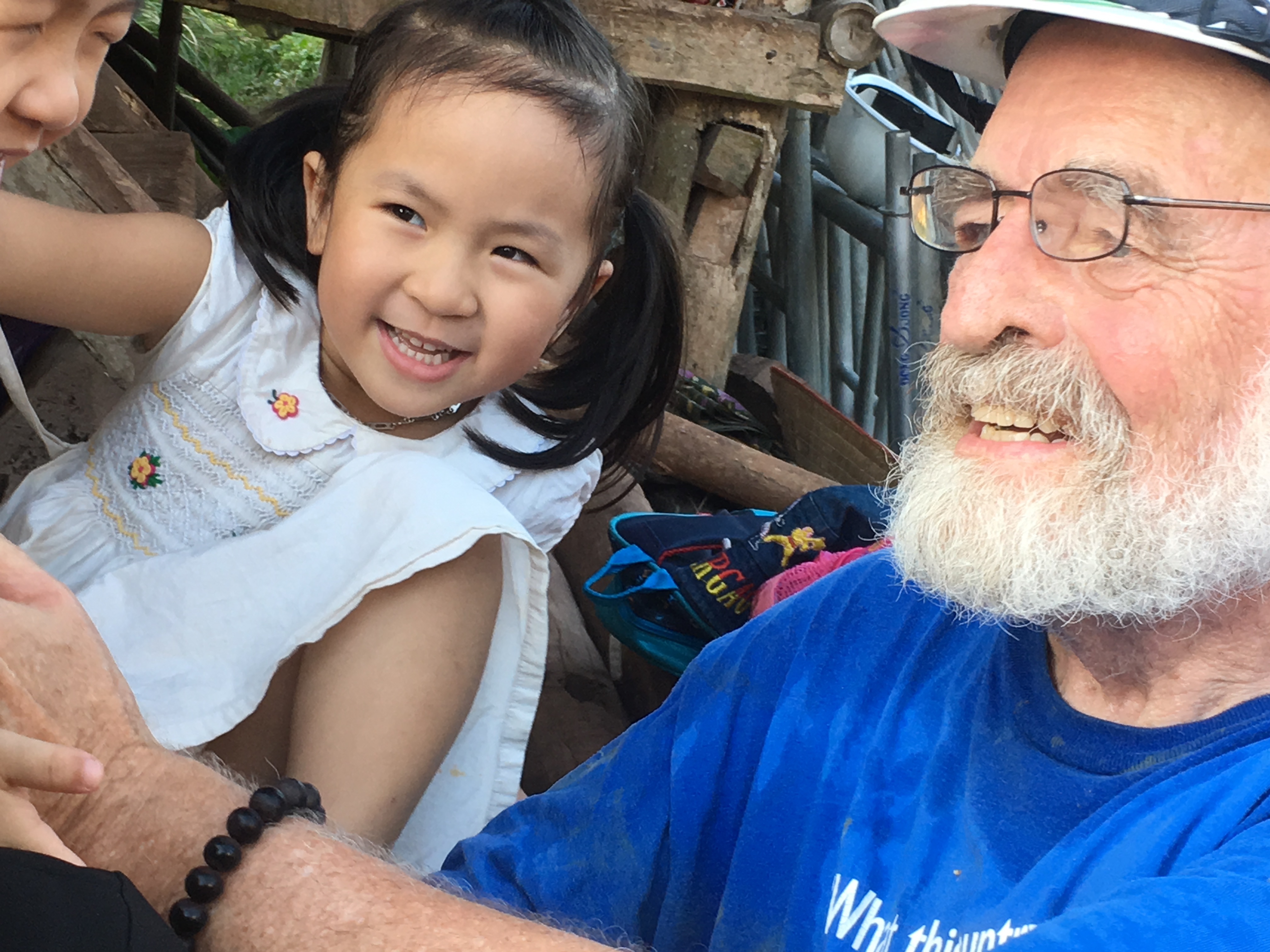
This photo was taken last year in a Muong community where we were building a home with the family. Here, my friend, Dan, a pediatrician who served time in prison as a young man for resisting the draft during the Vietnam war and one of the kids in the village. Helping a family in need is one way that people together can bond after war to rebuild what was destroyed.
It is never lost on me that a great part of my coming of age in the United States of America in the early 1960’s was influenced by the war in Vietnam. The books I have written reflect how war in general has been crucial in forming my world view.
This year, especially, I am conscious of all the divisions in our world, both internally in the United States of America and within the global family. The story of Vietnam and our country’s participation brought all of us such harm and division . Habitat For Humanity offers a study in how countries and former combatants can try to reconcile.
Today Vietnam is not at war. It is a very young country with the median age being 30.9 years of age. During that conflict, 2 million Vietnamese civilians were killed and 58, 000 Americans were killed in the war. One of the soldiers’ names etched on the Vietnam War Memorial in Washington, D.C. is a childhood friend. In the War Remnants Museum in Saigon I saw photos of other friends of mine who protested the war. In many ways, all of our lives are still connected and our country remains divided by that war.

Young students in Saigon who wanted to speak English, an impromptu class is a common occurrence if you are sitting and reading, writing on sketching in a park.
Habitat for Humanity builds homes where once fire rained down on villages and paddy fields. Vietnam is not a perfect, idyllic society but it is young and energetic and rebounding from a demoralizing and tragic time. I think there are lessons to be learned here for our own country. I do believe we must be warriors for peace and reconciliation as ardently as our country has called upon us in the past to be warriors for war. In that spirit, I hope to illustrate in subsequent blogs that I post some efforts toward that spirit of reconciliation.
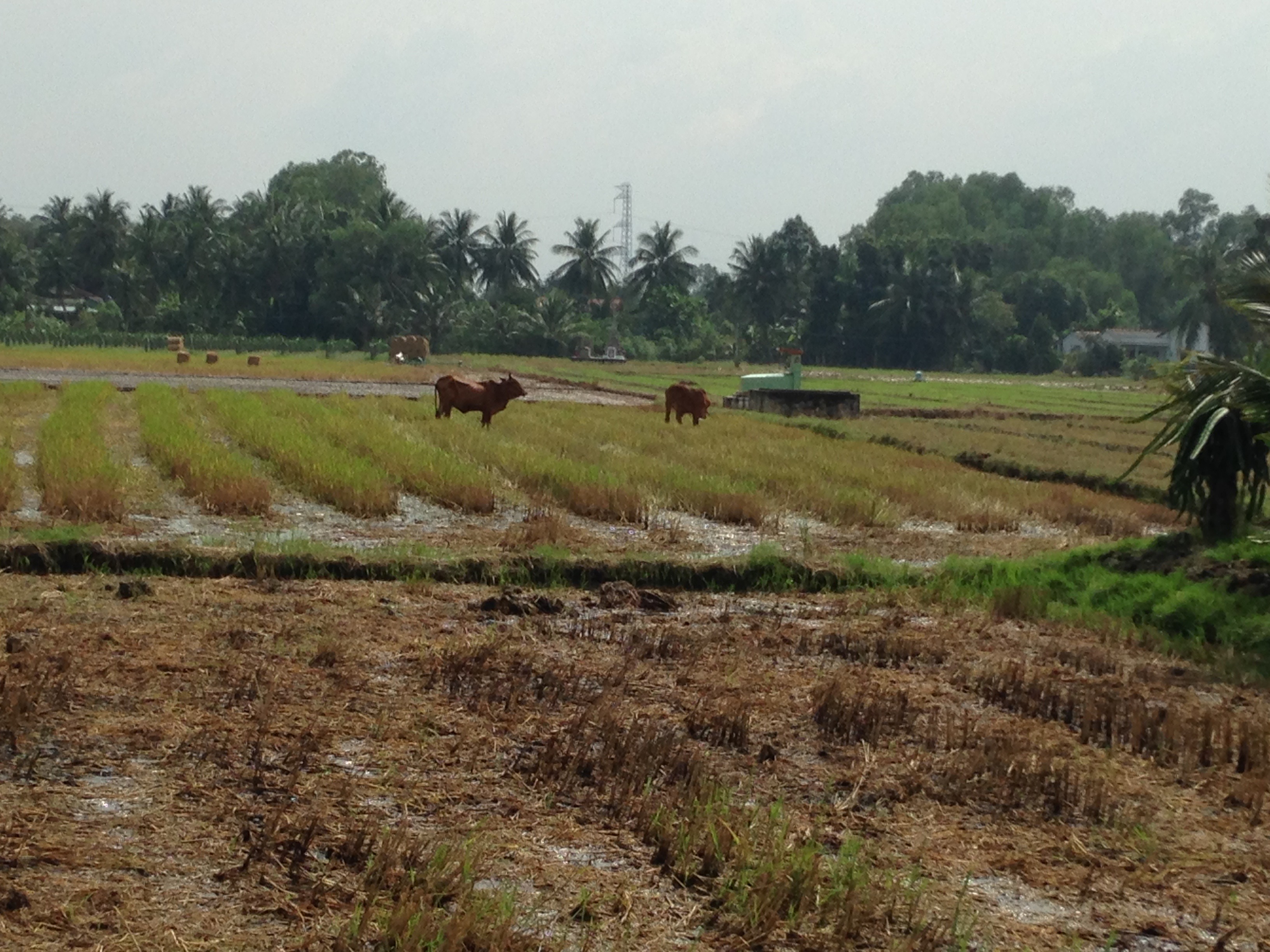
A tranquil paddy field we crossed in the Mekong in order to get to the building site two years ago.
I will only be taking an iphone with me to Vietnam so I hope I will be able to continue these postings without interruption. However, I will publish one more entry before I leave on the 17th that tells the emerging story of a collaboration between the Peaks Island Elementary School on Peaks Island, Maine where I live and Hoi Xuan Elementary School, a rural, elementary school on the Mekong. This is a private venture in kids to kids communication through drawings that a few of us have undertaken beyond that of our Habitat for Humanity involvement. The kids on Peaks Island live near the water on Casco Bay and the kids in Hoi Xuan live by the Mekong. What are the similarities and what are the differences in these two global villages? The kids have begun to illustrate these differences by sharing drawings of their lives and sending the drawings back and forth to their home schools. The photo below is a teaser for the next blog entry I will post before departing for Vietnam.

Getting ready in Hoi Xuan to draw the story of their lives to share with the kids on Peaks Island, Maine.
Vietnam and City of Belief
December 27, 2017 § Leave a comment
Everyone has an opinion on the Vietnam War as well as everyone has an opinion on the recent Ken Burns documentary on the Vietnam War. My first book, City of Belief, documents, under the guise of historical fiction, my and my friends’ coming of age experiences during that time. We have become and are a part of our country’s disparate, contradictory and combatitive historical memory of that chapter in American history.
A little over a week ago, I was in Vietnam as part of a Habitat for Humanity Global Build in the Mekong Delta. I went with two friends who I worked with at the Catholic Worker in the 1960’s, Dan Kelly and Paul Mann, both draft resisters during that war. Dan served two years in federal prison and Paul, sentenced to three years, had his jail sentence reframed to serving time in National Service.
I landed in Tan Son Nhat airport on December 2 and walked out into Ho Chi Minh City but part of me landed in the old Saigon and news reportage circa 1960’s in my head of that airport under attack. These were superimposed images that would come from time to time as I visited locations that were, in my early twenties, always flickering on tv screens in American living rooms or being written about with fervor in newspapers. Indeed, as the Ken Burns series has revealed and our current political climate in the United States continues to reveal, we remain a nation divided on that war and on any number of political and social issues that were the cultural spin-offs from that era.
That said and because I have my own “take” on what I experienced during that time, I am going to present via this blog a little slice of what I saw in Ho Chi Minh City that has a direct bearing on experiences re-imagined in City of Belief.
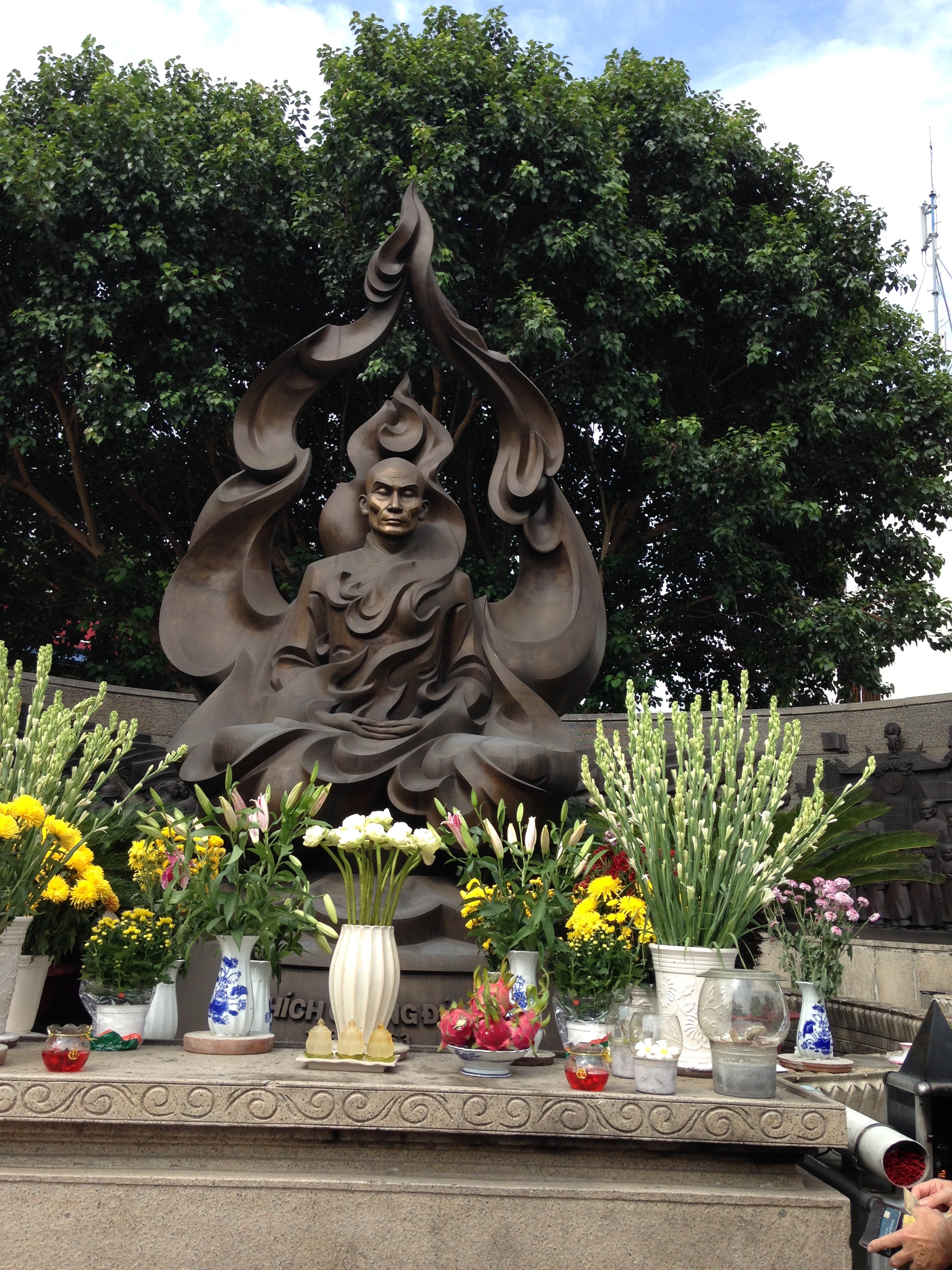
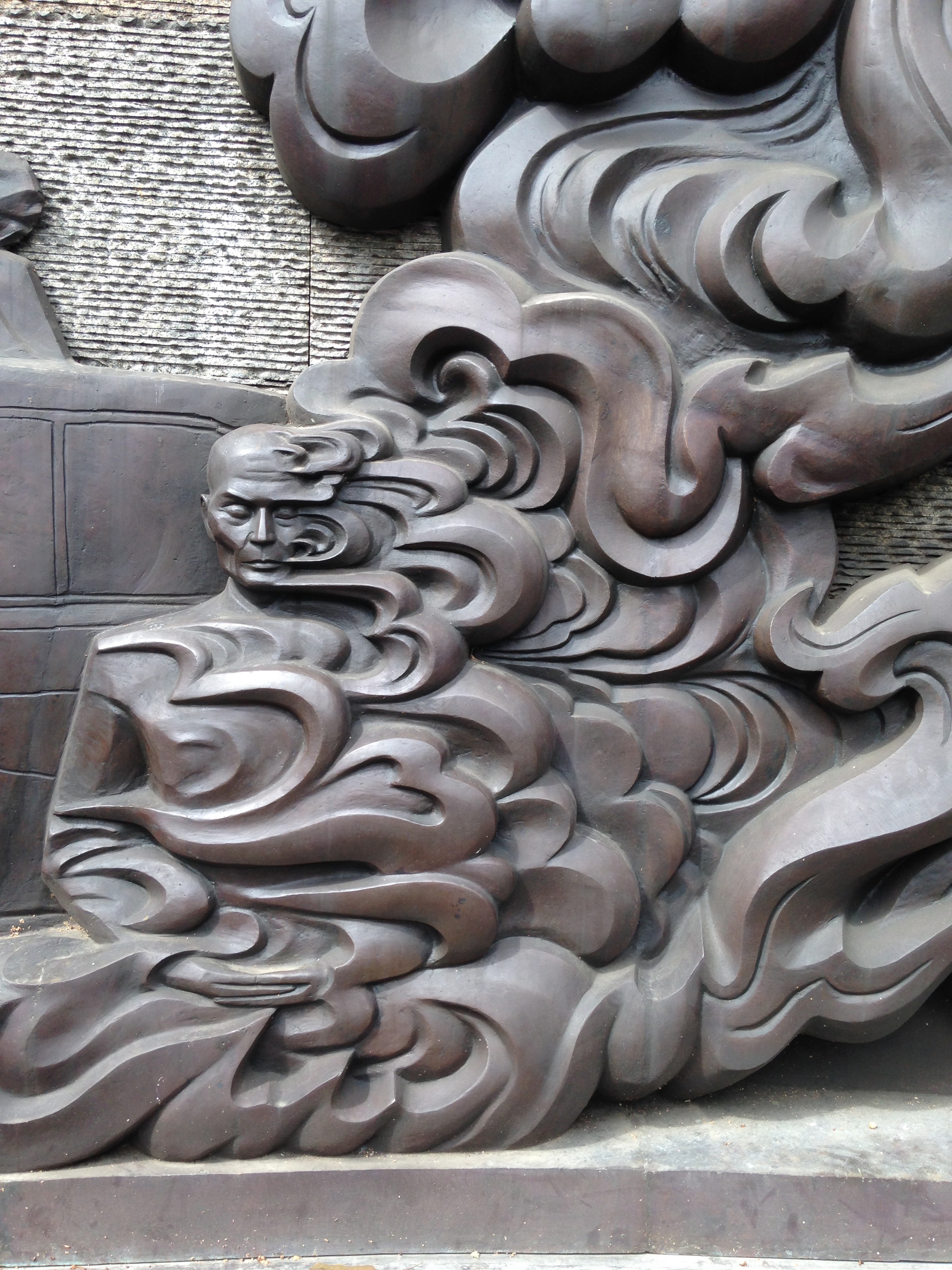
The first day walking around Ho Chi Minh, Paul took us to see the memorial to Thich Quang Duc who on June 1963 immolated himself on a Saigon street protesting the persecution of Buddhists by the South Vietnamese Government. The photographic image of that somber act appeared in newspapers across the world and was one of the first images to be burned into the psyche of the American public. In some ways, it introduced the complex ferocity of that war. The three of us visiting the memorial placed sticks of incense on the alter and watched as the thin, wavering trails of smoke lifted up along with our private intentions.
Next we went to The War Remnants Museum. The following three photographs are displayed in a section of the museum devoted to the story of United States protest to what is referred to in Vietnam as the American War.
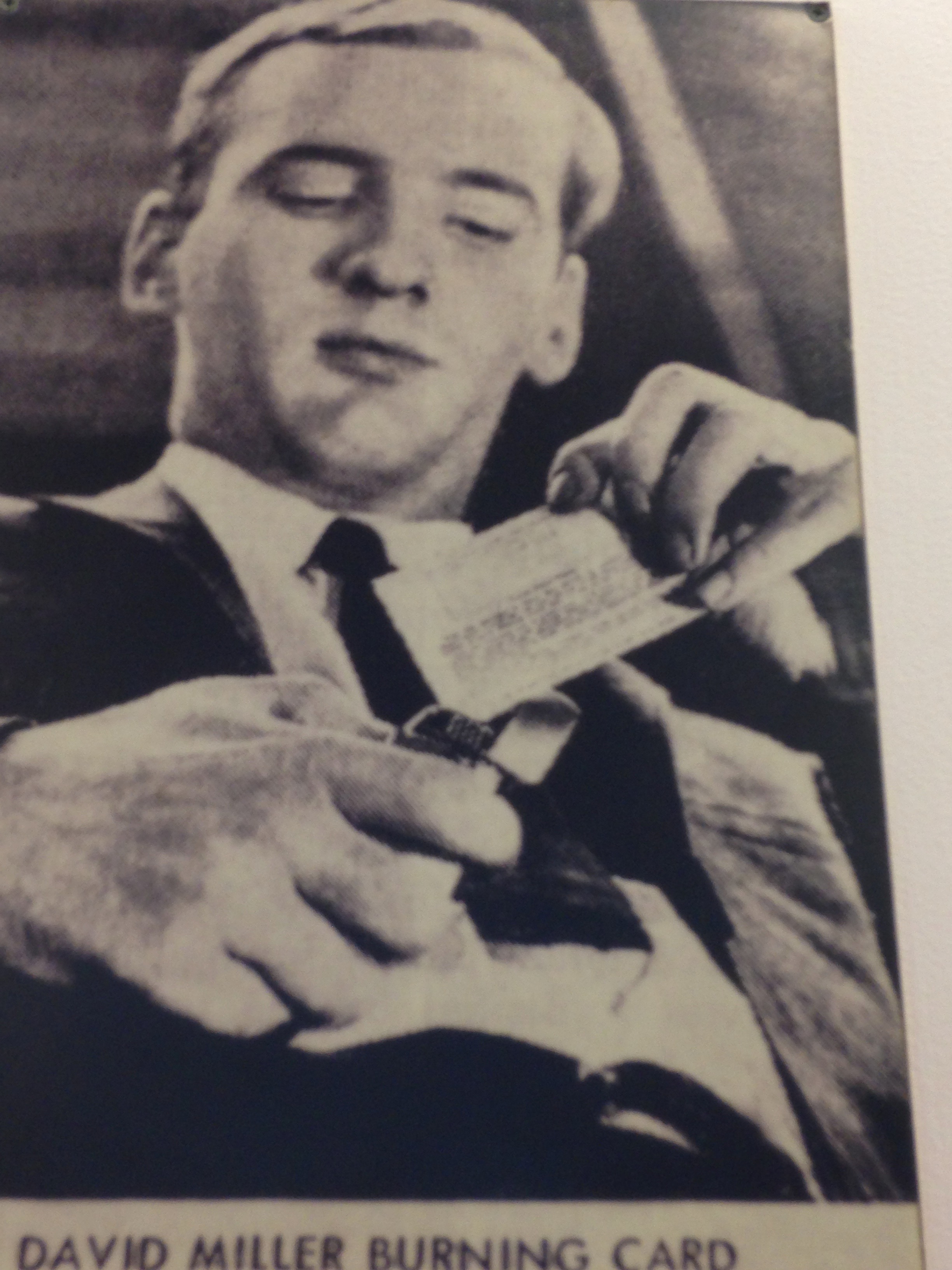
The first photograph is that of David Miller, Catholic Worker friend and colleague, who in September 1965 was the first man to publicly burn his draft card after President Lyndon Johnson made it a Federal crime to do so punishable by 5 years in prison. Dave subsequently served three years for draft refusal.
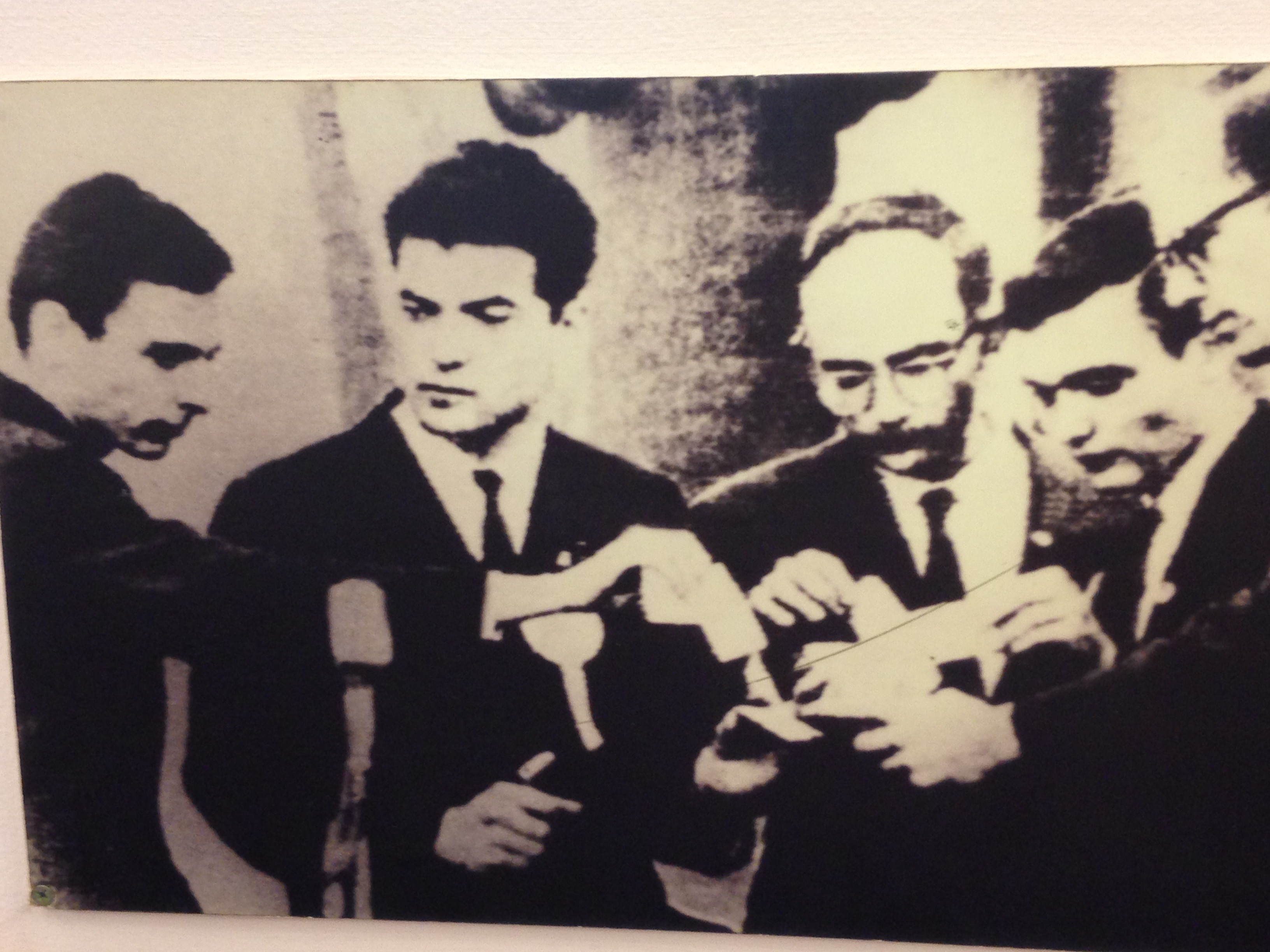
The second photo found in the museum is that of the public draft card burning in Union Square in November 6, 1965. On the left is Tom Cornell, a founder of the Catholic Peace Fellowship, next is Mark Edelman, a cabinet maker, alongside him is Roy Lisker, a teacher, next to Roy is Jim Wilson, a Catholic Worker friend and colleague and the youngest of the draft card burners and, finally, David Mc Reynolds of the War Resisters League. For those of you interested in some archival footage that depicts the tumult of the time, the following PBS account is accurate.
Finally, the last photo and most jarring for me, is of our friend and Catholic Worker colleague, Roger La Porte, who immolated himself in front of The United Nations in NYC in the early hours of Nov. 9th, 1965. His story, as I recall it, is told in City of Belief.

We were all young and the war in Vietnam is our story also. All of us have made our separate peace. May our country do the same.


